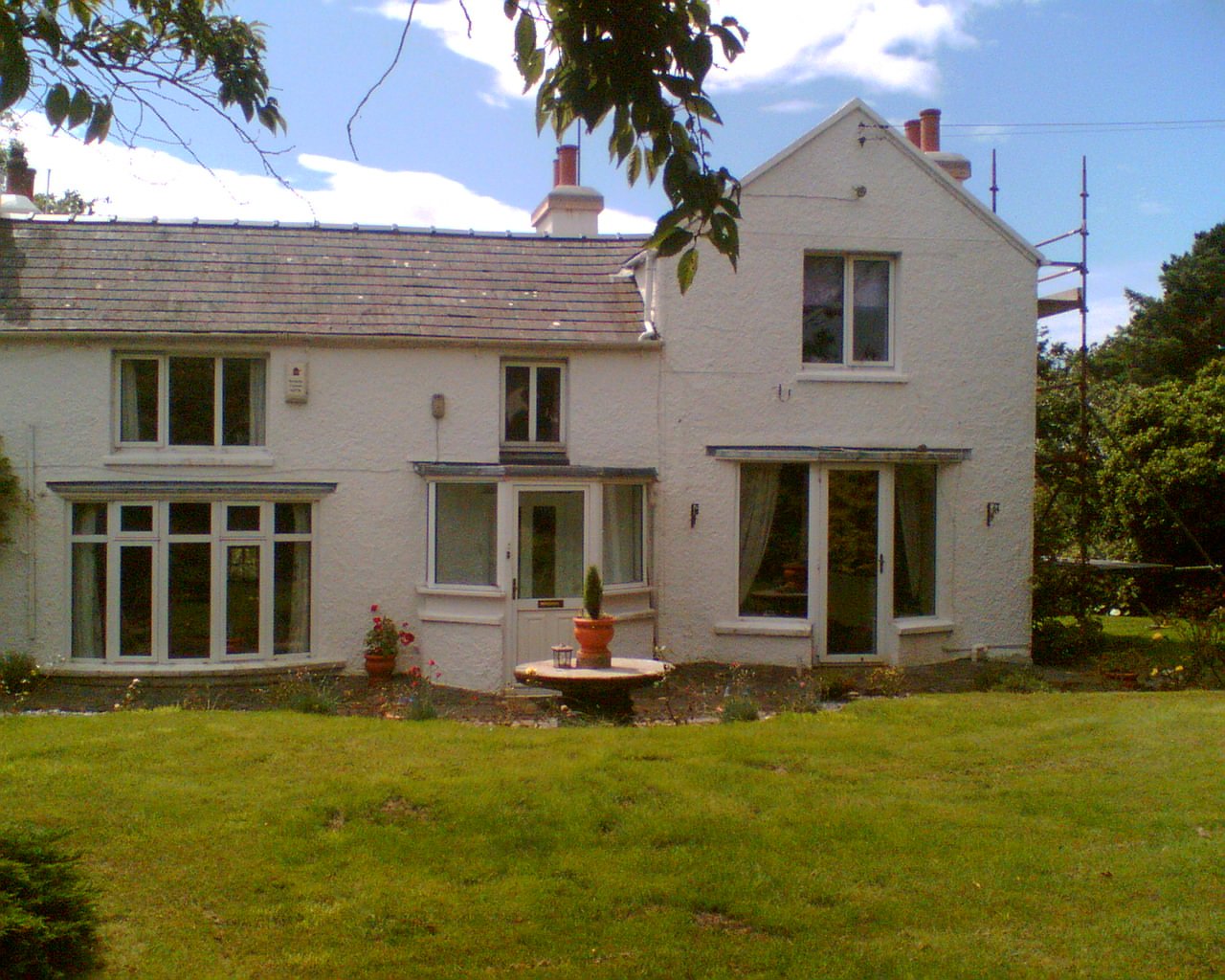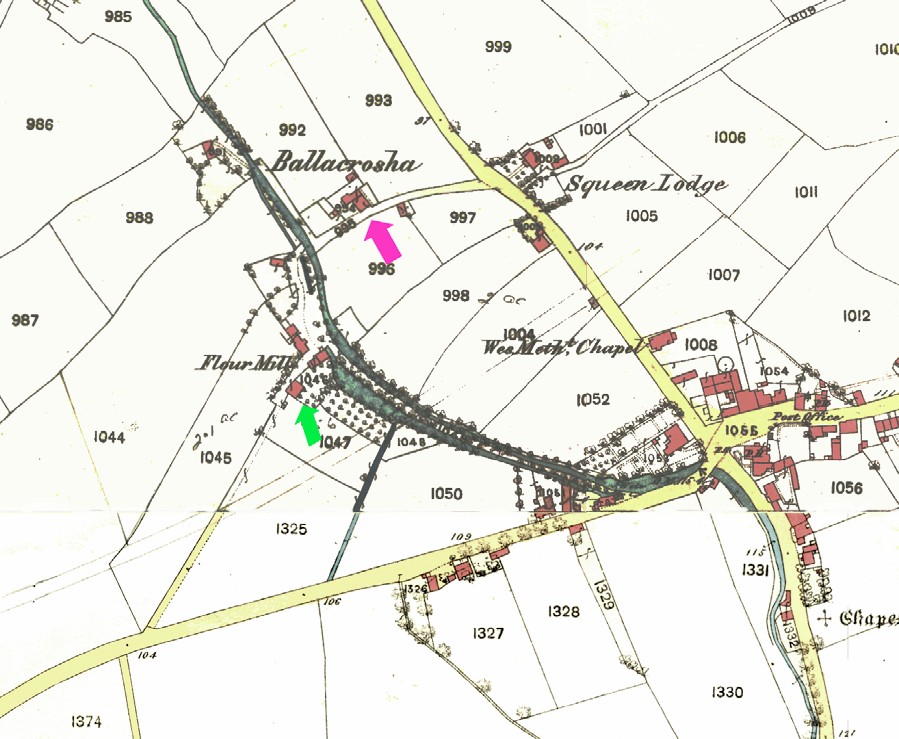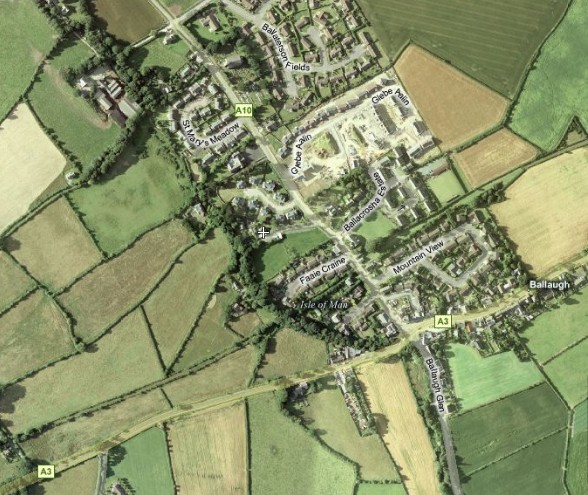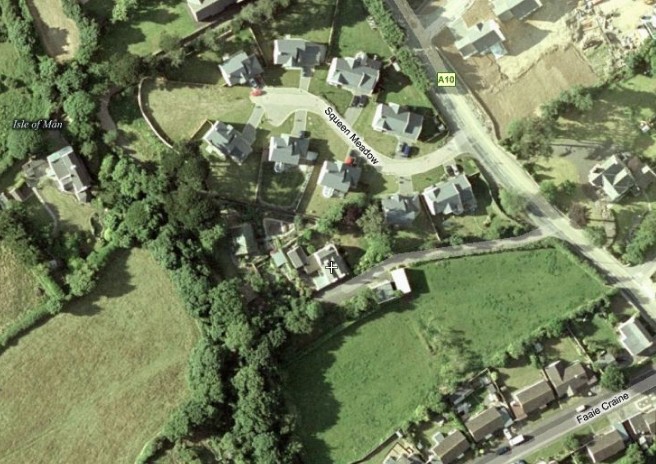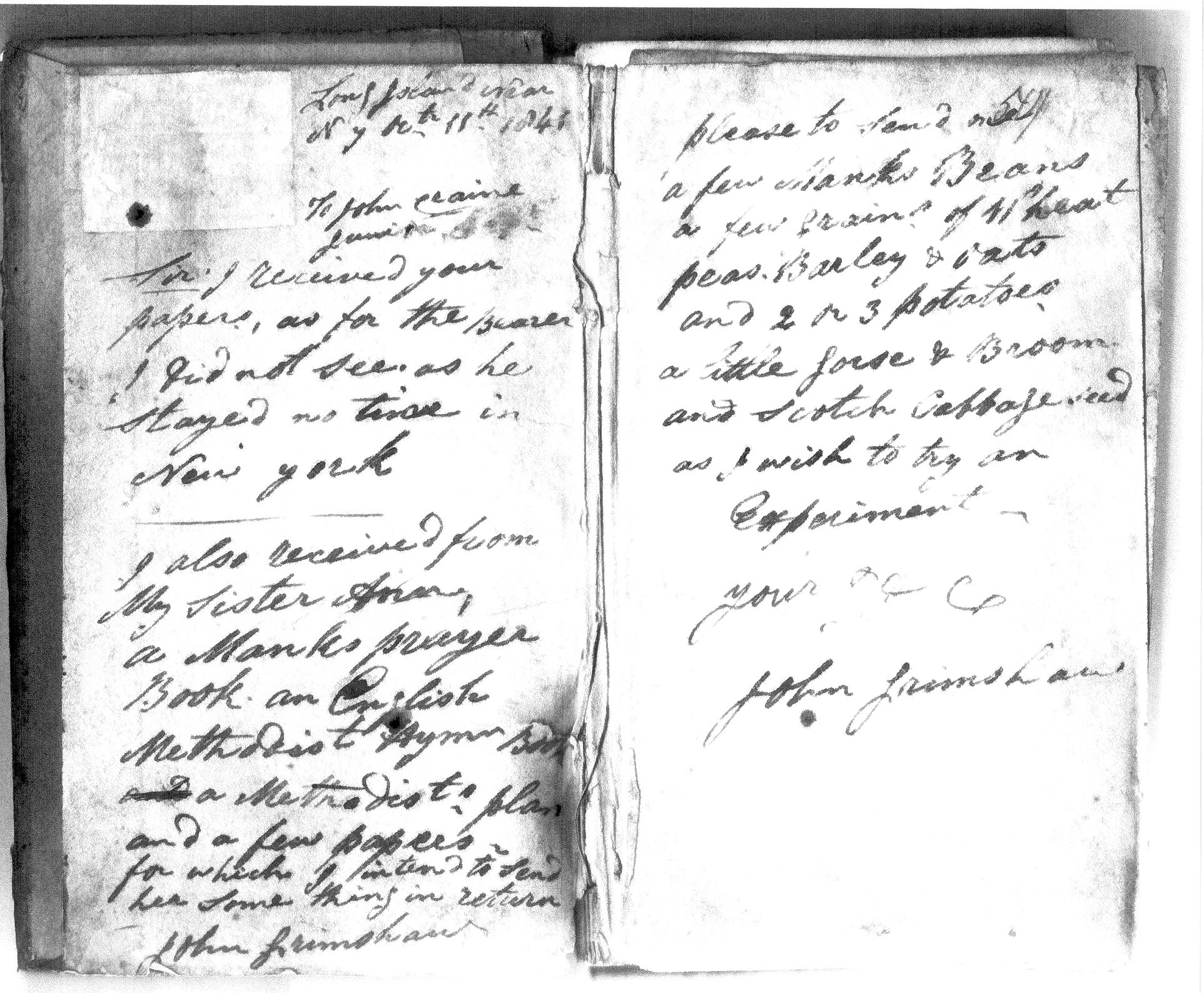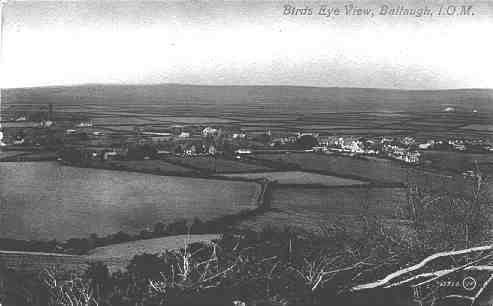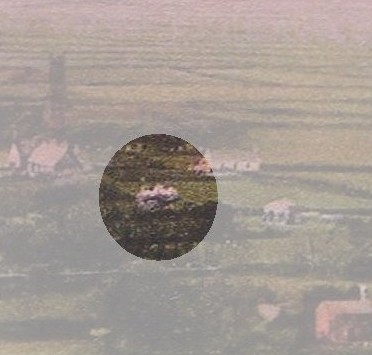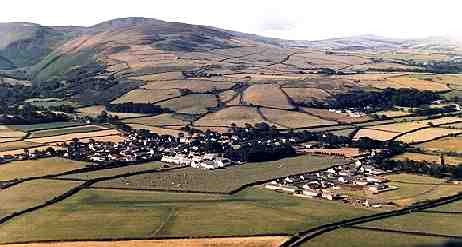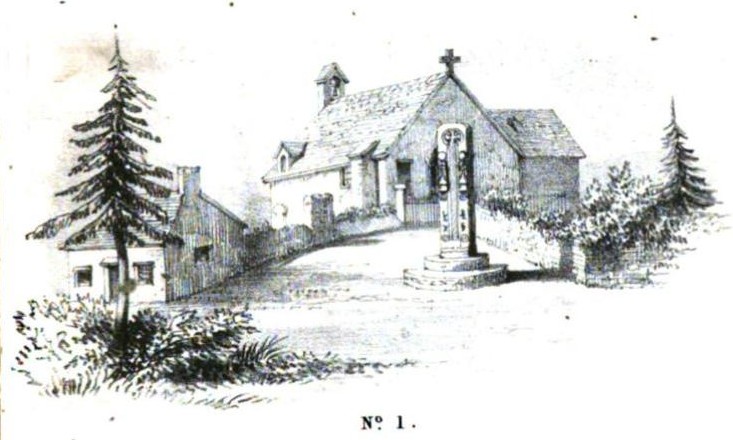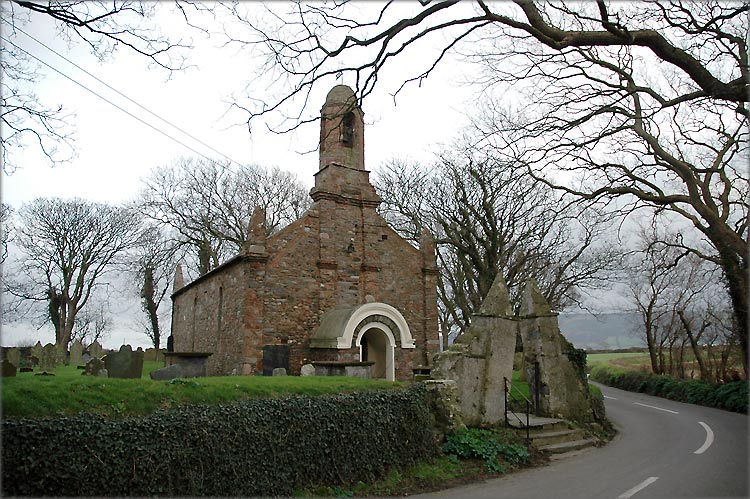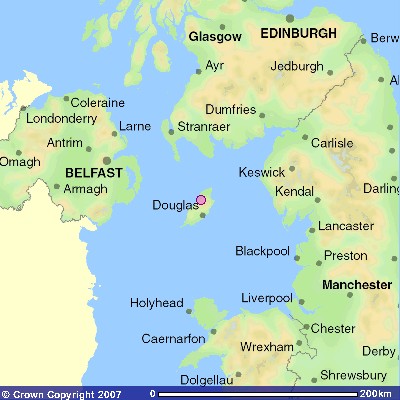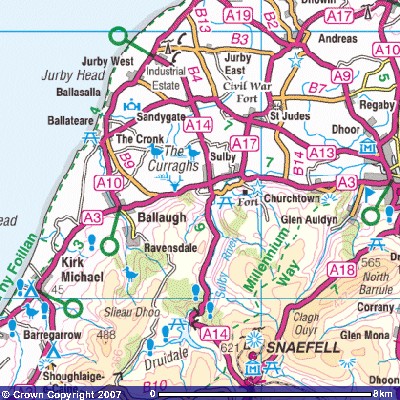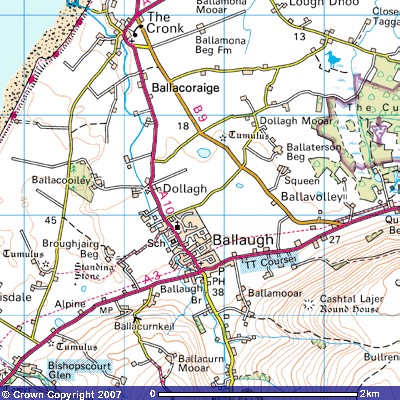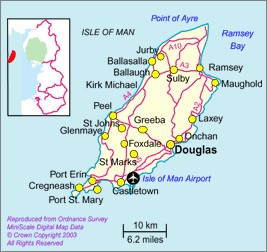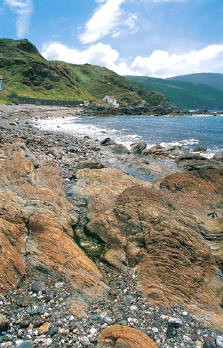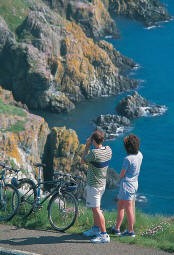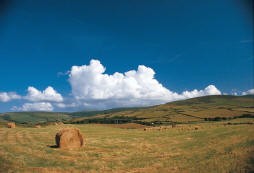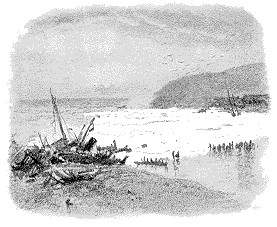Grimshaws on The Isle of Man
Progenitors of Three Lines of Immigrants to the U.S.
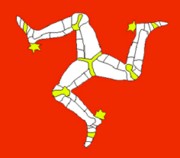
The flag of the Isle of Man shows a triskelion, the Three Legs of Man emblem, in the center of a red flag.
A number of Grimshaws lived on the Isle of Man in the late 1600s, 1700s and 1800s. Earlier records of these Grimshaws are primarily from Kirk Michael, and later records are mostly from Ballaugh. The earliest record located thus was for Essabell Grimshaw, who was a christened in 1643. Her father was indicated as Thomas Grimshaw, who may have been the original Grimshaw immigrant (presumably from Lancashire). At least three Grimshaws have been recorded as emigrants to the U.S. from the Isle of Man. By the early 1900s few if any Grimshaws apparently remained on the Isle of Man.
Contents
Deed of Sale of Cronk Breck to Thomas Grimshaw by William Kneen
The Dressmakers of Ballaugh, Who Met in Cronk Breck
Two Contemporaneous Grimshaw Families in Ballaugh
John and Thomas Grimshaw Voted for a New Church in 1830
William, John, Philip and (Maybe) Thomas Grimshaw, Manx Immigrants to the U.S.
John Grimshaw Book Sent from New York to the Isle of Man
Grimshaw Family Information Provided by Dr. J. F. Craine
Records of Wills from Isle of Man Family History Website
Grimshaw Family Lines Identified for the Isle of Man
Hypothesized Family of Origin for John and Thomas Grimshaw
What Does The Village of Ballaugh Look Like?
Kirk Michael and Ballaugh Old Church
Where Is the Isle of Man, and Where Is Ballaugh?
Published Descriptions of Ballaugh
Thomas Grimshaw Was a Casualty in the Loss of the Herring Fleet in 1787
Webpage Credits
Thanks go to Dr. J. Ffynlo Craine of the Isle of Man for providing much of the information that made this webpage possible.
Grimshaw Croft in Ballaugh
Grimshaw Croft, now named Cronk Breck, is located in Ballaugh. This dwelling was apparently occupied by Thomas and Catherine (Cowley) Grimshaw. If so, the three (and possibly four) Grimshaw emigrants from the Isle of Man to the U.S. were probably born in this house. Photos and maps of the home are shown below, courtesy of Dr. Ffynlo Craine.
The location of the former Grimshaw’s Croft in Ballaugh is shown below. The map is from Dr. F.J. Craine. The pink arrow shows Cronk Breck, which was known as Grimshaws Croft in early 19th century. The area shown is approximately 400m square and is taken from 1870 survey.
Dr. Craine has also provided satellite imagery of Ballaugh, which is shown below. Cronk Breck is under the “+” sign in the center of both photos. A smaller scale view is provided first, with Cronk Breck indicated ont he west side of Ballaugh. A larger scale view is shown below.
Source: http://www.flashearth.com/?lat=54.311244&lon=-4.544892&z=19.3&r=0&src=msl
Deed of Sale of Cronk Breck to Thomas Grimshaw by William Kneen
A deed of sale, executed in April 1787, of Cronk Breck to Thomas Grimshaw by William Kneen has been provided by Dr. Craine. A transcription is shown below. It would be reasonable to conjecture that Thomas bought the land from a relative, since Thomas married a Catherine Cowley, and William Kneen’s wife was “Catherine Kneen otherwise Cowley”.
Know all men by these presents that I William Kneen of the parish of KK Michael by and with the joint consent and approbation of Catharine Kneen otherwise Cowley my wife for and in consideration of the sum of Forty pounds and fifteen shillings currency of this Isle already paid & satisfied unto me by at and from the hands of Thomas Grimshaw of the parish of Ballaugh. Have given granted alienated passed over Sold and by these presents do give grant alienate pass over and for ever absolutely sell unto him the said Thomas Grimshaw his Heirs Executors administrators and assigns all and singular that parcel of our Estate of Land situate in the parish of Ballaugh called Cronk Brack being of Squeen’s Quarterland & of such Lord’s Rent as the Setting Quest shall adjust thereon and adjoining the Rent of William Corlet of Ballaterson beg on the North, the Highway leading to Ballaugh church on the East, the rent of Robert Gawn on the South and the Rents of John Kneen and John Corlet on the West. To have and to hold unto him, the said Thomas Grimshaw his Heirs and Assigns the said premisses with its ways waters watercourses Easements liberties Profits Issues Hereditaments and appurtenances to the same belonging for ever as aforesaid commencing from the date hereof yielding and paying the Lord’s Rent of the premisses with all Boons suits and services annually incumbent thereon. And I the said William Kneen and Catherine Kneen my said wife do hereby covenant & agree by and with the said Thomas Grimshaw that we our Heirs and Assigns shall awarrant maintain & defend the said premisses and its appurtenances in the peaceable possession of him the said purchaser his Heirs Executors Administrators and Assigns against the right Title Challenge and Demand of all and every person or persons whomsoever to the same. And for the faithful and true performance of all and singular this Deed of Sale I the said William Kneen and Catherine Kneen otherwise Cowley my wife do bind and oblige ourselves our Heirs Executors Administrators and Assigns in the penalty of Eightyone pounds and ten shillings currency of this Isle. As witness our subscriptions this 10th day of April 1787
Wm Kneen my X
Catherine Kneen my X
Signed and delivered in presence of
Patrick Cannel my X
Dan Stephen
19th April 1787
Wm Kneen and Cath. Kneen the executing parties to the before written Deed of sale acknowledged the same to be their Act & Deed and to be paid the consideration money.
Robt Farrant
We the Setting Quest of the parish of Ballaugh do settle and proportion on the premisses mentioned in the beforegoing deed of sale to bear and pay the yearly lords Rent of one shilling and eight pence. As witness our subscription this 27th day of April 1787.
William Corlett
John Craine
John Corlett
William Kewley
At a Court Baron holden at KK Michael for the parishes of Michael Ballaugh and Jurby the 4th day of May 1787
The beforewritten Deed of sale being acknowledged before the High Bailiff of Peel and now openly published in Court and no Objection offered against it the same is therefore allowed of for and in the name and behalf of the most noble John Duke of Athol Earl Strange Lkord of mann & the Isles &c and confirmed by this Court.
?? Heywood
The Dressmakers of Ballaugh, Who Met in Cronk Breck
An interesting aspect of the history of Grimshaw Croft (a.k.a. Cronk Breck) related to the Dressmakers of Ballaugh is shown below.
THE DRESSMAKERS OF BALLAUGH
Now that we are so used to buying our clothes from department or chain stores or from catalogues, probably made in distant parts of the world such as Taiwan or Korea, and from new materials like nylon, polyester, viscose, rayon etc. we might forget how they were hand-made at the beginning of the century, either at home or by dressmakers.
Ballaugh, in the early nineteenth century, was famous for its dressmakers, and in particular for a group who met in Cronk Breck, a house up a narrow lane on the opposite side of the A10 road, facing the former Rectory. This, in 1910, was owned by a Craine family, two of whom were women missionaries. While they were away they rented the house to Flo and Kitty Quayle, who lived at “Squeen”, not to be confused with Mwyllin Squeen (Squeen Mill) close by on the other side of the river.
The group consisted of six or seven women and girls, headed by Etty Wade (Hester or Hetty) who were trained, two at a time, over a period of years, for most of them just to be able to make their own dresses, others to provide garments for people who brought their own material to be made up to designs they had chosen. They came from all parts of the Island, many from Peel, because they appreciated the workmanship provided by the Cronk Breck group. It was said of them that the sewing was so neat that you could wear the garments inside out! In contrast to more organised apprentice dressmakers, Cronk Breck girls were not expected to do any cleaning – someone else was employed to do that, because it would make their hands too rough for sewing! Cronk Breck has been added to and extended but in those days there were two rooms downstairs and two up, with a kitchen which ran right along the back. One of the rooms was the cutting room where Flo Quayle, the tailoress, kept the stock of materials, measured with a yard stick, cut out the garments from illustrations chosen by her clients, and where fittings took place. The other downstairs room was where the seamstresses worked, doing the more tedious jobs such as over-sewing from left to right to avoid the thread getting in the way, tidying the seams on the Singer treadle sewing machine, lacking the garment together for the first fitting, sewing on buttons and hooks and eyes, making ‘dress protectors’. Among the more specialised jobs were faggotting, whipping, rouleauing, smocking, pin tucking, making plackets and gores, pleating and making buttons, and for very special evening gowns, sewing on sequins and beads.. They would work with oil lamps after dark and in winter, from 8.30 in the morning until 6.30 with one hour for lunch. Materials in those days were, amongst others, velvet, velvetine, crêpe de chine, satin, voile, foulard, seersucker, gingham, piqué, Viyella, all kinds of woollen materials, many woven from Manx wool in Tynwald mills, and after the 1914/18 war, parachute silk at 1/- a yard.
Of the six who worked at Cronk Breck, the head of the group was Hester (Hettv or Etty) Wade who was Johnny Wade’s daughter and lived with him at Dollagh Beg Farm, a little way down river. When the group dispersed in the 1920’s she continued dressmaking at home until, in 1926, she went to Liverpool to look after her brother. There were two sisters in the group, Florence (Flo) and Catherine Therese (Kitty) Quayle, daughters of Johnna who lived in Squeen, a farmhouse across the river from Cronk Breck. Kitty later married George Nicholas Wade of Dollagh Beg Farm, in November, 1920. Florence (Flo) married J. Edwin Boyde of Ballacoraige Croft, the Curragh, who started the well- known tailoring and dressmaking business in Parliament Street, Ramsey, where, later, girls from Ballaugh were apprenticed. He died in 1979, aged 95.
There were, of course, other dressmakers in Ballaugh, including Anna Kinrade living opposite the present garage, who taught Alice Corlett, Arthur Mylroie’s mother, and also Lizzie Cowell, so that Ballaugh seems to have been a centre for making garments in those days before the art was mechanised by industrial-type machinery which did all the fancy stitches at speed and could be operated by low-paid labour from all parts of the world, although still, of course, you could pay the price and buy hand-made couturier garments.
Another important member of the group was Kathleen (Katie) Joughin, now (1996) 93 years old. When the group broke up she went to work with Hetty Wade at Dollagh Beg Farm until unfinished work was cleared up – mostly blouses, probably about 1920, and then in “Manxonia” in Douglas until she married, in 1927. Others were Annie Leece of Sandygate, Katie Christian (Mrs. John Cowley) of Jurby West and Mona Harrison, niece of Edwin Boyde, the tailor.
Girls leaving school were sometimes apprenticed to dressmakers, starting between the ages of 14 to 16 when one of their main jobs was to sweep the floor before leaving at night and first thing in the morning to pick the pins out of the sweepings with a magnet. They did the fetching and carrying, delivering to customers and waiting on the seamstresses. At the long table they might do some over- oversewing or other basic jobs, in one case being told to hold a button in the palm of the hand with the little finger to avoid catching the thread! At the end of perhaps of a year, they were called ‘improvers’ and worked on their own. Finally after two years, they qualified as dressmakers or tailoresses earning (in 1930) 2/6d. a week. No longer, it seems, are young girls taught by their mothers to make dresses for themselves or even to do the simplest of mending jobs and there is nothing like the old ‘Girls Friendly Society which encouraged home needlework.. The tailoring course at the College of Further Education did not open until 1975. Nowadays there are so many jobs available to girls leaving school, but in the 1920’s and 30’s there were only three options: ‘going into service’, dressmaking or marriage. This, of course, is what is known as progress, but it seems sad that the art of making one’s own clothes has been lost and that Ballaugh is no longer famous for its dressmakers and tailors.
When the Cronk Breck group broke up the house was left empty for a number of years and gradually deteriorated to the extent that when the next owners, the Macaskies, first inspected it they found grass growing knee deep in the rotten floors and plaster failing from the ceiling. However, under the plaster were some good oak beams, possibly ships’ timbers, so they decided it was worth restoring and they bought it from the Craine sisters who were living in a flat over the then Westminster Bank, re-roofed it, put in drains to replace the cess-pit, and added two oriel windows on the west side. They were told by David Craine, the historian, that under the flagstone in front of the porch door a Viking’s remains had been found, with leather thongs still twisted round the leg bones, together with some broken pots and pieces of a spear. These were sent to the Manx Museum by David Craine, who said that the site of Cronk Breck had been occupied for many centuries and had also been an early Christian chapel before it became a farmhouse, the home of the Craine family, ‘two cottages back-to- back, lived in by two brothers, farmers. The Craine family donated two East windows in the Parish Church. The Macaskie’s ancestor, Gilbert, had been a Senechal of Man during the reign of Edward II of England, so that it was fitting that other members of his family should come back to the Island to live and to save and improve a building on such a historical site, and embellish it-with a garden full of flowering trees and shrubs. (These facts are given by the kind permission of Mrs. Macaskie in 1996)
Squeen was bought from Johnny Quayle by Commander Parkes, R.N., Aide de Camp to the Governor, greatly enlarged and extended by a glass-roofed billiard room, so that it looked very much as it does today (1996) glimpsed from the road (the A10) across a field in front of Cronk Breck. Commander Parkes married as his first wife, the eldest of the Craine sisters, and had a daughter by his second wife, Beth. who married Gordon, Bishop of Sodor and Man. It was sold to Richard Waller in 1957 and then to R.F. Stiles in 1993.
The approach to Squeen was a lane which ran beside the village school but there was a path along the river to Cronk Breck and on, under the railway bridge, joining the main Kirk Michael road near the present garage which, in those days, was where the cookery classes were held for the school.
Although not directly connected with dressmaking, across the river, which is banked by a profusion of bluebells in Spring, over a narrow bridge, there is another property of great social history interest- Mwyllin Squeen, one of the two water mills in Ballaugh, the other being Scrondal, in the Glen, older than the Squeen, mentioned in the Manorial Roll of 1513, serving the quarterland. These mills were called by the generic name ‘corn’ mills which covered many kinds of grain – wheat, barley, oats, rye and ‘pearl,’ barley. Mwyllin Squeen served the crofters round about, according to David Craine in his Mannanans Isle. This is now derelict and overgrown, but a detailed reconstruction of its plan by Dr. L.S. Garrad in 1967 gave its date as being built in 1736. The property now belongs to the Craine family whose father, Charles Cowell Craine, son of John Robert of Brough Jiarg, Captain of the Village, acquired it from Johnny the Cregg, and later, in 1964, bought it from the family estate.
Owners or occupiers before the Craines were a Corlett, then a Fayle, and then another Corlett, a butcher with a shop in Ballaugh, who used a small building attached to the mill as a slaughter-house, now a stable. He lived in Mwyllin Squeen from about 1900 to 1914 when he moved to Ballacrye. Next to the ‘slaughterhouse’ is another smaller extension used, it is said, as a washhouse. Propped up against its wall there is one of the millstones, and another is outside Cronk Breck front door, used as a garden table. On the north side of the ‘street’ a modern garage has been built on to part of the old threshing mill. The farmhouse itself is still unaltered except for a large modern extension built on to the back. In the ground round the house now (1996) temporarily overgrown with weeds, there is evidence of a real gardener’s garden, once cared for lovingly and with knowledge by Janet, Charles’ wife. Every year an orchard of sonic 30 fruit trees still crops generously supplying friends and family with apples, pears, plums and cherries.. An ambience of happy family life still persists overcoming its temporary neglect and waiting for another member of the Craine family to bring it back to life. The farmland round about must have been very extensive and
included what is now a small modern ‘estate’ called Faaie Craine, after Charles Craine, who died in 1979.Since the Ballaugh river dries up in the summer months in its lower reaches, Mwyllin Squeen must have been a part-time mill, only working to grind the corn newly harvested when the autumn rains created a flow of water enough to drive the water wheel. Scrondal Mill, serving the whole quarterland, has a flow of water all through the year. Probably in the past the river disappeared underground at or near the present War Memorial, as it does today (1996). The reason for this, no doubt, is that it is there that the subsoil becomes typically sandy and gravelly and able to absorb the water. Geologists could confirm this theory.
The lane loading to Cronk Breck and Mwyllin Squeen is immediately opposite what was once The Rectory. In 1877 Rector Kermode, who was the last Rector to live in the Old Rectory at the Cronk, an antiquarian, paid for and oversaw the building of a ‘new Rectory near the Parish Church, St. Mary of Ballaugh, built in 1833, converting a typical 4 room Manx farmhouse, called ‘Squeen Lodge’ into a pseudo Victorian family house, which from then on was occupied by a series of Rectors, one of whom used to hold classical music ‘evenings’ in the big drawing room, and another, in the same room, a meeting of the Mothers’ Union. In the old days domestic help was readily available to run such a large house, but in 1977, when the Reverend Theo Childs retired, after 7 years incumbency, it was decided to build a new, smaller, modern house in the grounds of the Rectory with less costly upkeep. While waiting for a purchaser of the existing building it was lived in by a family during whose occupancy a fire broke out and the building was gutted. During its rebuilding, in one of the first floor bedroom walls, which had been part of the original Manx farmhouse, the skeleton of a horse’s head was found, with two boar’s tusks stuck in the jaw, set into a joist hole. This discovery, of course, gave rise to much investigation and surmise by antiquarians and folklore experts, and the usual great exaggeration in the local press and village word of mouth exchange. (For full details, see an article by Yvonne Hayhurst in Vol. 100 of ‘Folklore’, in the Manx Museum).
The present owner of the building, now erroneously called The Old Rectory, transformed it from its original Victorian aspect into a hotchpotch of exterior additions and excrescences. A great number of trees in the once wooded grounds were cut down and the garden ‘landscaped’ to include a very small pond and a grand new drive to the front door. The sweetly scented privet hedge was destroyed, together with patches of fine crocuses at the back gate, so familiar to passers by.
So the third Squeen was changed from Manx Farmhouse, to Rectory, to modern ‘property, leaving only Squeen, Mwyllin Squeen and Cronk Breck as examples of Manx heritage.
Mrs D Dobby
Summer, 1996
Mwyllin Squeen
From Larch Garrads plan: possible date of origin of mill: 1736 “Lightly incised on a red sandstone datestone”.
Arthurs Contribution
First name of miller Corlett, then a Fayle, then another Corlett, John, a butcher with shop in Ballaugh main road, father of Alice Corlett (born 28.2.1886). He moved to Mwyllin Squeen bout 1900 and lived there until 1914 when he moved to Ballacrye. He used the building attached to the west wall of the mill as a slaughterhouse.
John Robert Craine was caption of the Village.
There was a cottage (possibly where the Mac bungalow now stands, to which a family of Taylors moved when floods moved them away from Ballacrye.
Arthurs mother was a Craine living at Mwyllin Squeen?
Johnny the Creg (Johnny Quayle) who had two daughters – Mary and Anne. It was then the Corn Mill which served the crofters round about who took their grain there to be milled.
David Craine – “Manannans Isle”
The Killane mill, SC 340969 GBM 24/039, was the manorial corn mill for Jurby.- ‘From Patrick McBrew for the mill of Carlane, with the freshwater fishing there, by the year, demised to him, 17s’- It collected its water by way of a complicated series of drains from a large area of marsh curragh land; in the seventeenth and eighteenth centuries it was held by members of the Christian family (MMMs 5608-19c). Like most other Manx mills its most recent buildings are of local stone and its roof of imported slate; it has recently been renovated as a dwelling.
The Isle of Man, by L. S. Garrad, T. A. Bawden, J. K. Qualtrough, W. J. Scatchard. P 220
Two Contemporaneous Grimshaw Families in Ballaugh
Two Grimshaw families were recorded in Ballaugh in the mid-1700s — John, who married Joney Cannell, and Thomas, who married Catherine Cowley. John was born in 1751, some time before than Thomas, who was born in about 1761. It is likely that John and Thomas were brothers.
Thomas and Catherine (Cowley) Grimshaw raised a large family on The Isle of Man (probably at Cronk Breck, as noted above). The christening dates for their children are shown in the descendant chart below, from the LDS Family Search website:
Thomas Grimshaw (ca. 1761, Ballaugh, Isle of Man) & Catherine Cowley Married 4 Feb 1786.
|—–Margaret Grimshaw (ch. 13 Jan 1787, Ballaugh, Isle of Man -?)
|—–Catherine Grimshaw (ch.8 Feb 1788, Ballaugh, Isle of Man -?)
|—–John Grimshaw (ch.28 May 1791, Ballaugh, Isle of Man -18 Jun 1797)
|—–Mary Grimshaw (ch. 14 Jul 1793, Ballaugh, Isle of Man -?)
|—–Thomas Grimshaw (ch. 17 Jan 1796, Ballaugh, Isle of Man -?)
|—–Anne Grimshaw (ch. 13 May 1798, Ballaugh, Isle of Man -?)
|—–John Grimshaw (ch. 22 Jan 1801, Ballaugh, Isle of Man -?) & Jane unknown
|—–|—–John Grimshaw (?, Isle of Man – ?)
|—–|—–Catherine Grimshaw (?, New York – ?)
|—–Philip Grimshaw (ch. 2 Oct 1803, Ballaugh, Isle of Man -?) & Julia A unknown
|—–William C Grimshaw (ch. 27 Jul 1806, Ballaugh, Isle of Man -?) & Phoebe Cain
As noted, John Grimshaw was older than Thomas. The following descendant chart and information have been located for John Grimshaw.
John Grimshaw (24 Nov 1751, Kirk Michael) – 21 Mar 1817, Ballaugh) & Joney (Booy) Cannell (ch 2 Nov 1756, Ballaugh – 29 Oct 1837, Ballaugh).
|—–John Grimshaw, Jr. (1787, Ballaugh – 13 Sep 1789, Ballaugh)
|—–Jane Grimshaw (ch 20 Jan 1790 – ?)
|—–Margaret Grimshaw (ch 30 Nov 1792, Ballaugh – 4 Jan 1844, Ballaugh) & Nicholas Cannell, Jr. Marred 21 Dec 1823).
|—–|—–Jane Cannell & unk Lawson
|—–|—–Judith Cannell
|—–|—–John Cannell
|—–|—–William Cannell
|—–|—–Thomas Cannell
|—–Anne Grimshaw (ch 26 Nov 1797, Ballaugh – ) & Thomas Caley. Married 4 Feb 1827, Ballaugh.
John GRIMSHAW
CHRISTENING: 24 NOV 1751, Kirk Michael IOM
DEATH: 21 MAR 1817, Kirk Michael IOM
Joney Cannell Grimshaw’s Will:
IGI Film #106419 Ballaugh 1818BURIAL: 21 MAR 1817, Ballaugh Cemetery
REFN: wlr
Family 1: Joney (Cannell) GRIMSHAW
MARRIAGE: BFR 1786,
Her mother’s 1786 will lists Joney Grimshaw
No Ballaugh marriage record listed
Joney (Cannell) GRIMSHAW
CHRISTENING: 22 NOV 1756, Ballaugh IOM
Joney Cannell Grimshaw’s Will: IGI Film #106419 Ballaugh 1818
Kirk Ballaugh Parish Christening Records FHL Film #0106707:
“22 Nov 1756 daughter of John Cannell and Joney Crain/Craine.”
BURIAL: 29 OCT 1835, Ballaugh Cemetery
ALT INFORMATION: homestead – Ballamoar
From Her mother’s will: “Fiftly — She left and bequeathed unto her Daughter Joney Wife of John Grimshaw the Sum of six pounds Her smoothing Iron, a Blanket and the other Half of her shaped woolen and linen Apparel aforesaid.”
REFN: wlr chr map
Father: John CANNELL III
Mother: Joney (Craine) CANNELL
Family 1: John GRIMSHAW
MARRIAGE: BFR 1786,
Her mother’s 1786 will lists Joney Grimshaw
No Ballaugh marriage record listed
MARRIAGE ENDS with DEATH of SPOUSE: 21 MAR 1817
John GRIMSHAW Jr
BIRTH: 1787, Ballaugh IOM
Margaret Quayle Cannell’s Will IGI Film #106419 Ballaugh 1818 IGI date
BURIAL: 13 SEP 1789, Ballaugh IOM
Ball[augh] Burial Record page 63:
“John son of John buried 13 Sep 1789 age 2”
REFN: wlr bur
Father: John GRIMSHAW
Mother: Joney (Cannell) GRIMSHAW
Jane GRIMSHAW
CHRISTENING: 20 JAN 1790, Ballaugh IOM
Margaret Quayle Cannell’s Will IGI Film #106419 Ballaugh 1818
igi
REFN: igi
Father: John GRIMSHAW
Mother: Joney (Cannell) GRIMSHAW
Margaret (Grimshaw) CANNELL
BIRTH: 1792
wec
Margaret Quayle Cannell’s Will IGI Film #106419 Ballaugh 1818
CHRISTENING: 30 NOV 1792, Ballaugh IOM
Ballaugh Parish Christening Records FHL Film #0106707:
“30 Nov 1792 daughter of John Grimshaw and Joney Cannell”
DEATH: 04 JAN 1844, Ballaugh IOM
Ballaugh Monumental Inscriptions Book 00.5:
“Sacred to the memory of Margaret Cannell wife of Nicholas Cannell who died 4th Jan 1844 aged 51 years.”
BURIAL: JAN 1844, Ballaugh Cemetery
Jan 1844 Ballaugh Burial Register 1598-1986 Book page 17:
“Margaret als Grimshaw Cannell age 51 years buried.”
REFN: wlr chr gsi bur
Father: John GRIMSHAW
Mother: Joney (Cannell) GRIMSHAW
Family
1: Nicholas CANNELL JR
MARRIAGE: 21 DEC 1823, Kirk Ballaugh IOM
Kirk Ballaugh Parish Marriage Records FHL Film #0106707:
“21 Dec 1823 married her cousin Nicholas Cannell Jr son of Nicholas Cannell and Jane Corlett.”
Anne (Grimshaw) CALEY
CHRISTENING: 26 NOV 1797, Ballaugh IOM
Margaret Quayle Cannell’s Will IGI Film #106419 Ballaugh 1818
Ballaugh Parish Christening Records FHL Film #0106707:
“26 Nov 1797 daughter of John Grimshaw and Joney Canel”
REFN: wlr chr
Father: John GRIMSHAW
Mother: Joney (Cannell) GRIMSHAW
Family : Thomas CALEY
MARRIAGE: 04 FEB 1827 Ballaugh IOM
IGI Record Ann GRIMSHAW Thomas CALEY
Marriage: 4 Feb 1827 Ballaugh, Isle Of Man, England
Source Information: Batch number: M038011
Source: http://junior.apk.net/~ctd/d0001/g0000097.html
formerly: http://apk.net/~ctd/d0000/g0000099.html#I535
John and Thomas Grimshaw Voted for a New Church in 1830
A records of an 1830 Vestry Meeting indicate the presence of John and Thomas Grimshaw in Ballaugh. Their names are shown in bold in this record, shown below.
Vestry Meeting 24th April 1830
Acknowledgement:
This copy of the meeting by parishioners of Ballaugh Church to petition for or against the removing of the Parish Church of St. Mary, Ballaugh, was copied by hand from the Official Copy from the Parish Register of Ballaugh (also copied by hand by the Rector of Ballaugh from the original), and then typed from this copy. by Susanne Dougherty, for whom I am grateful for the copy (nb It has not been checked against the original)
Text
At a vestry held in the Parish Church of St. Mary Ballaugh, in pursuance of legal notice given the preceding Sunday, to take into further consideration the state and condition and the removing of the said Church, as recommended by The Legislature. It is resolved in Vestry that the said Church is in a ruinous and dilapidated state and condition as appears by the return of the Jury duly empanneled to survey the same, and from the smallness and situation thereof is incapable of any considerable improvement or addition so as to accommodate the parishioners with convenient seats or pews. Resolved therefore that a new Parish Church be erected on the north west corner of a certain field, commonly known by the name of Magher y Raad mooar on the quarterland of Ballaterson beg, the property of Thomas Corlett adjoining the high road from the present church to the Village of Ballaugh on the west, and on the North by the old road between the two estates of Ballaterson and that an acre of said field be purchased for the said Church, and also for a churchyard which shall be enclosed with a sufficient stone wall, and which Church yard be allotted in the usual proportion for burial ground and the said new church to be of sufficient dimensions including a gallery on the west end there of to afford one pew or seat with a commodious door to each pew of or each quarter of land in the said Parish, and sufficient to contain eight full grown persons at the least, also sufficient to accommodate the Intack, Cottage, and Mill Holders with pews or seats in the usual proportion to the Quarterland seats, being in the whole fifty eight seats, besides six free seats, and that the Rector and Wardens do forthwith solicit the Legislature of the said Island for an Act of Tynwald for the sanctioning and confirming the removal of the site of said church as herein before mentioned and the re-building thereof as aforesaid, and that afterwards the said church be built and finished by the said Rector and Wardens, and such sidesmen as may be chosen to assist them, by a fair and equal assessment amounting to the sum of ten pounds Brits and no more on each quarterland and Intakes in proportion to be made and levied in the usual manner, and that whatever sum or sums be further necessary to the completion of the said Church (after expending the amount of said assessment, that is to say, five hundred and eighty pounds Brits) be paid by the The Rt Rev The Lord Bishop of The Diocese out of a fund raised in England for the building and
enlarging of Churches in the Isle of Man in testimony whereof The Lord Bishop sets his hand to this Act of Vestry. And that the said Church be built under the direction and supervision of the The Rt. Rev. The Lord Bishop of the Diocese according to his Ephiscophal right or jurisdiction as by Law established. That the said church be built of the dimensions and according to the plan of the interior exhibited this day to the Parishioners in Vestry assembled. It is also resolved that the old Church yard and the fence thereof shall be kept in repair by the Wardens for the time being in the same manner as it has been hitherto kept, and carefully preserved as usual. In witness whereof we subscribe our names this 24th day of April in the year of our Lord 1830.W. Sodor and Mann
|
James Kegg my x mk |
Hugh Stowell, Rector |
|
Elizabeth Quayle my x |
Thomas Taubman)Wardens |
|
Thomas Craine |
Hugh Callister ) |
|
Jane Corlett my x |
J. Maclean |
|
William Killip my x |
J. Teare Junr. |
|
John Teare my x |
J. Teare, Senr. |
|
Catharine Corlett my x |
John Caley |
|
Margaret Kerruish my x |
Thomas Kerruish |
|
Ann Myllycharane my x |
John Clarke |
|
Margaret Cowley my x |
John Corlett |
|
Margaret Quayle my x |
John Teare |
|
Ann Quayle my x |
Marg Caine my x mk |
|
Margt. Cowley my x |
Elizabeth Teare my x mk |
|
John Cowley my x |
John Cannon my x mk |
|
John Boyde my x |
John Kelly my x mk |
|
Edmond Dougherty my x |
Ann Corlett my x mk |
|
William Quayle |
Thomas Craine |
|
Jophn Kinreade |
William Corlett |
|
William Stephen |
Thomas Quayle |
|
Margt. Morrison my x |
Ann Hunter my x |
|
Thomas Corlett |
Jane Wade my x |
|
William Kewish |
Philip Brew my x |
|
Isabella Boyde my x |
Thomas Radcliffe |
|
Elizabeth Boyde my x |
Philip Craine |
|
John Kelly |
Robert Brew |
|
John Stephen |
William Craine my x |
|
John Corlett my x |
Thomas Corlett |
|
Charles Crow |
Thomas Grimshaw my x |
|
James Hunter |
John Craine my x |
|
William Watson my x |
John Grimshaw |
|
Ann Cowley my x |
James Callister my x |
|
Christopher Quayle my x |
John Killip my x |
|
William Craine my x |
Thomas Stephen my x |
|
Daniel Boyde my x |
John Quayle my x |
|
Thomas Myllycharane my x |
Daniel Keigg my x |
|
Daniel Kelly my x |
Philip Corlett |
|
Thomas Quayle my x |
John Craine |
|
R. Stephen my x |
Henry Taubman |
|
William Corlett my x |
Thomas Corlett |
|
Edward Taubman |
John Morrison |
|
John Corlett |
John Clarke my x |
|
Charles Shimmin |
Thomas Craine |
|
William Christian |
William Stephen |
|
John Cowley my x |
Henry Caine my x |
|
John Myllychrarane |
John Corkan my x |
|
Patrick Cowley my x |
Patrick Cannel my x |
|
William Craine |
Patrick Moddison |
|
John Mylrea my x |
Daniel Corlett |
|
William Cowley |
Thomas Stephen |
|
Philip Kneen |
John Corlett |
|
William Kelly |
Thomas Kneen my x |
|
Thomas Craine |
William Quayle my x |
|
William Teare my x |
Daniel Stephen |
|
Thomas Quayle | |
|
John Craine | |
|
Catharine Stephen |
Names of the persons in Vestry assembled who object to the removal of the Church from its present site – dated this 24th April, 1830.
SECOND TABLE HERE
|
Thomas Cowley ) |
Margaret Teare my x |
|
) Wardens | |
|
Stephen Kneale ) |
William Kneen my x |
|
William Corlett |
Catharine Kneale my x |
|
Daniel Craine |
John Cowel my x |
|
Edward Forbes |
Thomas Kaighen my x |
|
Esther Quayle my x |
Isabella Corlett my x |
|
John Killip |
Margery Caine my x |
|
Daniel Cowell |
Isabella Cleator my x |
|
Thomas Teare |
Eleanor Mylrea my x |
|
Thomas Callister my x |
Catharine Clarke my x |
|
Margaret Craine my x |
Eleanor Kermode my x |
|
William Cowel my x |
Jane Gawn my x |
|
Mary Corlett my x |
Margt. Kneen |
|
Thomas Killip my x |
Thomas Lace my x |
|
Ann Killip my x |
William Killip my x |
|
William Corlett my x | |
|
John Killip my x | |
|
John Hughes |
Ann Quine my x |
|
Thomas Callister |
Jane Morrison my x |
|
Thomas Fayle |
Isabella Corlett my x |
|
Judith Quayle my x |
Patrick Nelson |
|
Elizabeth Cannon my x |
Thomas Teare |
|
John Fayle my x |
Thomas Callister my x |
|
Thomas Nelson |
Thomas Corlett my x |
|
Jane Caine my x |
Richard Corlett my x |
|
Wm. Kaighin my x | |
|
Thomas Caine my x |
Thomas Gawne |
|
John Corlett |
Thomas Kaighen my x |
|
Thomas Callister |
Robert Corlett my x |
|
William Christery my x |
Robert Corlett |
|
John Cowley my x | |
|
John Callister |
Patrick Callister |
|
Wm. Myllycharane |
Thomas Cowel |
|
John Fayle |
Daniel Caine |
|
Robert Corlett |
Thomas Corlett my x |
|
Daniel Connan my x |
John Callister |
|
Jo;hn Froude my x |
Daniel Boyde my x |
|
John Myllycharane |
John Killip |
|
John Morrison |
William Killip |
|
Robert Kaighen my x |
John Keigg my x |
|
James Corlett my x |
Thomas Kneale |
|
Robt. Teare my x |
William Caine my x |
|
Thomas Corlett my x |
John Kerruish my x |
|
Thomas Kewley | |
|
Thomas Cowel my x |
110
84
26 majority in favour of the Removal of the Church.
N.B. The above documents were transmitted to The Episcopal Register April 26th 1830 to be enrolled in the Episcopal Registry by
H. Stowell, Rector
Memorandum – Sept. 27th. The New Church of St Mary Ballaugh was this day consecrated after much delay and many obstacles.
Gloria Deo in excelsis
“Bishop Ward presided over the vestry meeting of April 1830 that decided to build a new, and larger, church nearer the village. Bishop Ward laid the foundation stone, at a site of his choice, a mere month later. The £1714 cost was split £580 on a parish assessment with the remainder from the money the Bishop had collected in England for church building.”
Source: http://www.isle-of-man.com/manxnotebook/parishes/bh/vestry.htm
William, John, Philip and (Maybe) Thomas Grimshaw, Immigrants to the U.S. from the Isle of Man
At least three, and possibly four, Manx Grimshaws immigrated to the U.S. All four were apparently the children of Thomas and Catherine (Cowley) Grimshaw. Records of their immigrations are shown below.
William Grimshaw of Ironton, OH
A companion webpage describes William and Phoebe Grimshaw. The following is an excerpt from that webpage.
William C. Grimshaw was born in Great Britain (Isle of Man) and apparently married Phoebe Cain, who was born in Greenup, Kentucky, after immigrating to the U.S. William and Phoebe, arrived in Lawrence Co., Ohio in about 1847. They apparently had five children – Jennie, William Henry, Ann G. Noble B., and John E. Grimshaw. William Henry, Nobel and John subsequently moved to Illinois. William and Phoebe are apparently buried in Woodland Cemetery, Upper Township, Lawrence Co.
John Grimshaw of New York
John Grimshaw and his wife Jane were recorded in the 1850 U.S. Census of New York, as shown below. Since their older child, age 19, was born in the Isle of Man, and the younger one, age 16, was born in New York, the couple must have immigrated between 1831 and 1834.
Cindy O’Brian has found an 1850 U.S. Census record of William’s older brother, John, age 49, living in Bushwick, Kings Co, New York with his wife, Jane (age 51) and two children, John and a sibling (Samantha or Catharine), ages 19 and 16, respectively. This census record is shown on a companion webpage as follows:
New York, John and Jane Grimshaw
John and Jane Grimshaw were born on The Isle of Man and were living in Kings County, New York. He was 48 and she was 51; their children, John and Samantha, were 19 and 16 years old. John was born on The Isle of Man, and Samantha was born in New York. John was a toll gatherer. William Hurst (?), a laborer, was living with this Grimshaw family. [Author’s note: It appears that the daughter’s name, shown as Samantha in the 1850 census index, is more likely to be Catharine.]
Philip Grimshaw
Philip is recorded as immigrating in 1831 in the naturalization record shown below from a companion webpage. He must have married after immigrating, as his wife, Julia, was born in New York.
Myers, Mrs. Lester F., 1968
The record for Phillip is quite sparse (Myers, 1968, p. 21):
|
GRIMSHA, Phillip |
128 |
I — N |
21 |
Phillip was apparently a New York resident who was also an immigrant, as indicated by the fact that he was recorded in the “I—N” (Immigration Naturalization) pages that were indexed by the reference. Additional research would be required to obtain more detail on his immigration to the U.S. A dual page-numbering system (indicated by the numbers 128 and 21) is used in the index. The entry in the original reference is as follows:
GRIMSHA. Phillip, a native of the Isle of Man, Great Britain, declared his intention of becoming a citizen on June 10, 1831 in Court of Common Pleas, at Oswego, N.Y. He was a resident of Scriba. He took the Oath of Allegiance in Cayuga Co., Oct. 27, 1841. Witnesses, G.W. Foster and Ams Underwood declared that he had complied with the 5 year and 1 year residence requirements.
Philip and Julia Grimshaw were recorded in the 1850 U.S. Census in New York, as indicated in a companion webpage and shown in the record below.
New York, Philip and Julia GrimshawPhilip and Julia Grimshaw, ages 46 and 39, were living in New York City and had two teenagers with different surnames (Paddock and Morgan) also living in the household. Philip was born in England, Julia was a native of New York.
John and Philip Grimshaw Families in the 1860 U.S. Census
The 1860 U.S. Census found Jane Grimshaw, probably widowed, in Wayne County, New York with her children, John and Catherine. Philip and Julia Grimshaw are also recorded in Wayne County, as shown in the summary record below.
187
Grimshaw
John
Galen
Wayne
NY
27
1832
Isle of Man
M
188
Grimshaw
Catharine
Galen
Wayne
NY
25
1834
New York
F
189
Grimshaw
Jane
Galen
Wayne
NY
60
1799
Isle of Man
F
190
Grimshaw
Philip
Galen
Wayne
NY
56
1803
Isle of Man
M
191
Grimshaw
Julia A
Galen
Wayne
NY
48
1811
New York
F
192
Grimshaw
Martha
Arcadia
Wayne
NY
60
1799
England
F
Thomas Grimshaw
It is possible that John, Philip and William Grimshaw’s older brother, Thomas, also emigrated to the U.S., as indicated by the following record (see Thomas Grimshaw’s name in bold). Thomas may have arrived on the ship William Dawson in 1827, if this is a record for him. Although his age should have been 31 instead of 35, it was not uncommon for immigrants to be untruthful about their ages.
Known Emigrant Ships and Manifests
Introduction
This page attempts to list the ships the early Manx emigrants to Ohio traveled on – at present only those for 1826 and 1827 are included. I suspect, though currently have no proof, that after these years the route had become well enough known and with sufficient communication from friends or relatives already settled, for individual families to travel alone. The actual voyage, route to Ohio, costs etc are discussed elsewhere.
There were certainly other emigrants and destinations – Thomas Tear refers to a couple of families who travelled to New Brunswick and to Philadelphia in 1826
An index of immigrants arriving at New York from 1820-1840 exists, however it does not appear to be complete [having examined several such manifests I suspect that many names are present but mis-indexed]. Microfilms of the ship’s manifests are available and it is from these, mostly via the help of Tim Davis, that I have been able to put together this page. The act by which these manifests were required and availability of archival copies is discussed elsewhere. Several of these emigrants can be found in 1850 Ohio census, and various early immigrant documents (eg Pioneer Manx Women)
Liverpool Departures
Although no record was kept of emigrants at the ports of exit, it is possible by examining newspapers of the time to construct a list of sailings – the following list (not claimed to be complete) is based on sailing notices in the Liverpool Mercury (courtesy of Liverpool Central Library) for the four month period from April to July 1827.
….
1827
….
William Dawson
Liverpool Arrived New York June 18, 1827 (ref #355)
Phil Carlet 26 shoemaker Great Britain
o Jane 21
Mathias Quail [Quayle]26 mason
o Ann 23
Daniel Carlot [Corlett] 24 weaver Great Britain
o Wm 30 tailor
o Ann 30
o Jane 30
o Margt 17
Chas Comish (Cerush?) 55 farmer Great Britain
o Jane 55
o Mary 21
o Margt 22
o Will (?) 19
o Jane 16
o Ann 13
James Carlet 3
Thos Garret 1
Mathew Keowen (?) 40 tailor
o Jane 30
o John 3 ½
o Will 2 ½
o Ann 1
Eliza Kallen 70
Thos Grimshaw 35 farmer Not sure he is Manx, but listed with the others
Thos Carlet 31 laborer
Edwd Mathews 28 joiner Not sure he is Manx
Ann Ratcliffe 29
__?__ Callow 65 (female) Can’t read name
Source: http://www.isle-of-man.com/manxnotebook/famhist/genealgy/mfests.htm
John Grimshaw Book Sent from New York to the Isle of Man
John Grimshaw apparently sent a book back to the Isle of Man from New York with a message written in the front cover. Dr. Ffynlo Craine provided the following e-mail and attachments with this missive. This John Grimshaw is believed to be the immigrant described in the preceding section.
E-mail from Ffynlo Craine with attachment…
July 15, 2007
Thomas –
I visited my cousin this afternoon, and while chatting mentioned our correspondence. She got up and fetched a book which turned out to be a copy of the American constitution dated 1833. The reason why she did so is in the attached image. It shows a letter written to my GG grandfather John (1804-1862) on the inside of the front cover of the book.
Regards,
Ffynlo
PS – Here “gorse” would be Common Gorse (Ulex europaeus) used for hedging, not native to the Isle of Man, but now common everywhere here.

A transcription of the message is shown below.
Left Page:
Long Island Near
NY 10th 11th 1841
To John Craine
(unintelligible)
Sir ∙ I received your
papers, as for the Bearer
I did not see as he
stayed no time in
New York.
________________
I also received from
My Sister Ann,
a Manks prayer
Book an English
Methodist Hymn Book
and a Methodist plan
and a few papers ~
for which I intend to send
her some thing in return.
John Grimshaw
Right Page:
Please to send myself
a few Manks Beans
a few grains of Wheat
peas Barley & oats
and 2 or 3 potatoes
a little Gorse & Broom
and Scotch Cabbage seed
as I wish to try an
Experiment ~.
Your (unintelligible)
John Grimshaw
Grimshaw Family Information Provided by Dr. J. F. Craine
Dr. Craine provided many records for this website, which are shown below. These records form the basis of many of the interpretations on the Grimshaws of the Isle of Man on this webpage.
Initial E-mail from Dr Craine
From: “Dr. J. F. Craine”
To: thomas.w@grimshaw.com
Subject: Grimshaw, Ballaugh Isle of Man
Date: Wed, 20 Jun 2007
Hi, I just tripped over your site late this evening while looking for something completely different. I suspect that the Grimshaws in the Isle of Man were those who lived at the house adjacent to ours for 2-3 generations about 200 years ago – my family have been here for about 230 years. If you’re interested I’ll check through my files…
Ffynlo Craine
Subsequent E-mail
Date: Wed, 4 Jul 2007
My apologies for the delay in getting back to you. I’ve put some rather unsorted material into a PDF file. Make of it what you will, and let me know if I can be of any further help – assuming of course that this material is of help!! By and large the Manx Grimshaws seem to start disappearing about 1850. None appears in a list of property owners dated 1867. I had vaguely wondered where they went…
Regards,
Ffynlo
Records Provided
Dr. Craine provided Grimshaw information from the Ballaugh Baptismal, Marriage and Burial Registers, wills, Kirk Michael Burial Register, LDS International Genealogical Index Records, and the 1841 Census.
Ballaugh Baptismal Register
| GRIMSHAW | Thos | male | 01 JUN 1757 |
| GRIMSHAW | Anne | female | 24 FEB 1759 |
| GREMSHER | Patrick | male | 06 MAR 1763 |
| GRIMSHAW | Thos | male | 28 OCT 1785 |
| GRIMSHAW | John | male | 18 OCT 1787 |
| GRIMSHAW | Margrat | female | 13 JAN 1787 |
| GRIMSHAW | Cath | female | 08 FEB 1789 |
| GRIMSHAW | Jane | female | 20 JUN 1790 |
| GRIMSHOW | John | male | 28 MAY 1791 |
| GRIMSHAW | Margaret | female | 30 NOV 1792 |
| GRIMSHAW | Mary | female | 14 JUL 1793 |
| GRIMSHAW | Thomas | male | 17 JAN 1796 |
| GRIMSHAW | Anne | female | 26 NOV 1797 |
| GRIMSHAW | Anne | female | 13 MAY 1798 |
| GRIMSHAW | John | male | 22 JAN 1801 |
| GRIMSHAW | Philip | male | 02 OCT 1803 |
| GRIMSHAW | Wm | male | 27 JUL 1806 |
| GREMSHAW | John Thomas | male | 04 SEP 1831 |
Ballaugh Marriage Register
| Robert ROBERTS | Anne GRIMSHAW | 28 FEB 1786 |
| Thomas CALEY | Ann GRIMSHAW | 04 FEB 1827 |
Ballaugh Burial Register
| GRIMSHAW | John | son of John | 13 SEP 1789 |
| GRIMSHAW | son of Anne ROBERTS als GRIMSHAW | 18 MAY 1790 | |
| GRIMSHAW | John | son of Thos GRIMSHAW aged 89 yrs | 18 JUN 1797 |
| GRIMSHAW | Margaret pauper | 13 OCT 1804 | |
| ROBERTS Ann | SEE GRIMSHAW | 11 DEC 1814 | |
| GRIMSHAW | Ann | als ROBERTS | 11 DEC 1814 |
| GRIMSHAW | John | 21 MAR 1817 | |
| GRIMSHAW | Thomas | 28 JAN 1819 | |
| GRIMSHAW | Margaret | 05 JUN 1820 | |
| GRIMSHAW | Catharine | 14 DEC 1824 | |
| GRIMSHAW | Thomas | aged 74 yrs | 09 FEB 1832 |
| GRIMSHAW | Judith | 29 OCT 1835 | |
| GRIMSHAW | Margaret SEE CANNELL | — JAN 1844 |
Wills
Wills, from http://www3.telus.net/lawson/wills/gi-will.html
Last two columns are index in Manx Museum; I think these may have been microfilmed by the LDS. Mic is Kirk Michael, parish immediately to west of Ballaugh. Bra is Braddan, far enough away (15 miles) over hills to be probably unconnected. Mau is Maughold, on east coast of Isle of Man, could be connected.
| GRIMSHAW | John | 1817 | Ballaugh | E 1 | 0106419 |
| GRIMSHAW | Margaret | 1823 | Ballaugh | E 2 | 0106423 |
| GRIMSHAW | Catherine | 1825 | Ballaugh | A 45 | 0106244 |
| GRIMSHAW | Elinor | 1785-1 | Bradden | E w | 0106399 |
| GRIMSHAW | Thomas | 1787-2 | Bradden | E d | 0106400 |
| GRIMSHAW | Jane | 1822 | Maughold | E 2 | 0106423 |
| GRIMSHAW | William | 1720-3 | Michael | E w | 0106369 |
| GRIMSHAW | Cooney * | 1749-1 | Michael | E d | 0106379 |
| GRIMSHAW | William | 1794-1 | Michael | E d | 010640 |
| GRIMSHAW | John | 1829 | Michael | E 2 | 0106429 |
| GRIMSHAW | Ann | 1723-1 | Michael | A 13 | 0106212 |
| GRIMSHAW | Mary | 1781 | Michael | A 32 | 0106228 |
| GRIMSHAW | John | 1776-1 | Michael | A 34 | 0106227 |
| GRIMSHAW | John | 1776-1 | Michael | A 34 | 0106227 |
| GRIMSHAW | Margaret | 1792 | Michael | A 38 | 0106231 |
| *CREER als CANNELL |
*KK Michael May 29 1749
Cooney Grimshaw als Creer als Cannell departed this Life about the 9th instant Intestate. The Court upon Intelligence thereof decreed her both sons namely John Creer & Thos Creer joint adminrs of all her goods movable & immoveable. Thomas being abroad John
is sworn well & truly to administer the effects to bring a perfect inventory to the registry – and for payment of Debts according to law.
Pledges are Wm Cannell & Patr:Caine of Ballaugh
Solvit 3s 0d
Decretum Est
Edv: Moore
Kirk Michael Burial Register
| GRIMSHAW | Wm | 16 Nov 1720 | |
| GRIMSHAW | Ann | ALS CANNELL of Balla Faidjean | 30 Jan 1721 |
| GRIMSHAW | Anne | wife of Jon (on Bishop’s Demesne) | 8 Apr 1723 |
| GRIMSHAW | Esther | daughter of John | 17 Nov 1723 |
| GRIMSHAW | Jane E | SEE GAWN | 25 Jan 1742 |
| GRIMSHAW | Caensy | ALS CREER | 9 May 1749 |
| GRIMSHAW | John Senr | 6 May 1762 | |
| GRIMSHA | Margt | daughter of Thos ?? | Jul 1762 |
| GRIMSHA | Patr | son of John | 7 Jul 1766 |
| GREMSER | Anne | daughter of Thos (Bishop’s Demesn ) | 7 Feb 1774 |
| GRIMSHAW | John | 28 Jan 1776 | |
| GRIMSHAW | Thos | 11 May 1777 | |
| GRIMSHAW | Mary | 30 Jan 1781 | |
| GRIMSHAW | Elin | daughter of Thomas | 1 May 1782 |
| GRIMSHAW | Ann | daughter of Thomas | 5 May 1782 |
| GRIMSHAW | Elinor | 11 Jul 1784 | |
| GRIMSHAW | Ralph | 21 Jan 1787 | |
| GRIMSHAW | Margt | 9 Jan 1792 | |
| GRIMSHAW | William | 8 Jan 1794 | |
| GRIMSHAW | Jane | 26 Mar 1808 | |
| GRIMSHAW | Christian | wife of John | 1 Feb 1820 |
| GRIMSHAW | Ellinor | wife of William | 5 Oct 1822 |
| GRIMSHAW | John | 13 Sep 1825 | |
| GRIMSHAW | John | 8 Sep 1829 | |
| GRIMSHAW | Isabella | SEE KNEALE | 15 May 1857 |
IGI Records
|
Name |
Gender |
Record |
Day |
Mon |
Yr |
Location |
|
Essable Grimshew |
Female |
Christening |
24 |
Jun |
1663 |
Kirk Michael |
|
John Grimshaw |
Male |
Christening |
5 |
Mar |
1720 |
Kirk Michael |
|
Thomas Grimshaw |
Male |
Marriage |
10 |
Jul |
1742 |
Kirk Michael |
|
Jane Grimshaw |
Female |
Christening |
30 |
Oct |
1743 |
Kirk Michael |
|
John Grimshaw |
Male |
Christening |
26 |
Jan |
1745 |
Kirk Michael |
|
Thos Grimshaw |
Male |
Christening |
8 |
May |
1748 |
Kirk Michael |
|
Philip Grimshaw |
Male |
Christening |
15 |
Mar |
1749 |
Kirk Michael |
|
John Grimshaw |
Male |
Marriage |
20 |
Jan |
1750 |
Kirk Michael |
|
John Grimshaw |
Male |
Christening |
24 |
Nov |
1751 |
Kirk Michael |
|
Ann Grimshaw |
Female |
Christening |
12 |
Jul |
1752 |
Kirk Michael |
|
Thomas Grimshaw |
Male |
Birth |
Abt |
1752 |
Of, Kirk Michael | |
|
Thomas Grimshaw |
Male |
Birth |
Abt |
1752 |
Of, Kirk Michael | |
|
Willm Grimsha |
Male |
Christening |
15 |
Apr |
1754 |
Kirk Michael |
|
Margt Grimsha |
Female |
Christening |
25 |
Sep |
1754 |
Kirk Michael |
|
Danl Grimsha |
Male |
Christening |
12 |
Dec |
1756 |
Kirk Michael |
|
Thos Grimshaw |
Male |
Christening |
1 |
Jun |
1757 |
Ballaugh |
|
Anne Grimshaw |
Female |
Christening |
24 |
Feb |
1759 |
Ballaugh |
|
Margt Grimsha |
Female |
Christening |
27 |
Apr |
1760 |
Kirk Michael |
|
Thomas Grimshaw |
Male |
Birth |
Abt |
1761 |
Ballaugh | |
|
Thomas Grimshaw |
Male |
Birth |
Abt |
1761 |
Of, Ballaugh | |
|
Ralph Grimsha |
Male |
Christening |
15 |
Jul |
1764 |
Kirk Michael |
|
Isabel Grimshaw |
Female |
Christening |
1 |
Sep |
1774 |
Braddan |
|
Thomas Grimshaw |
Male |
Christening |
4 |
Jun |
1774 |
Braddan |
|
Ann Grimshaw |
Female |
Christening |
10 |
Apr |
1774 |
Saint Mathews, Douglas |
|
Mary Grimshaw |
Female |
Christening |
20 |
Mar |
1776 |
Braddan |
|
Thomas Grimshaw |
Male |
Marriage |
30 |
Nov |
1776 |
Kirk Michael |
|
Susanna Grimshaw |
Female |
Christening |
11 |
Feb |
1776 |
Saint Mathews, Douglas |
|
John Grimshaw |
Male |
Marriage |
1 |
Feb |
1777 |
Kirk Michael |
|
Ellinor Grimshaw |
Female |
Christening |
4 |
Jan |
1778 |
Kirk Michael |
|
Ellr. Grimshaw |
Female |
Christening |
4 |
Jan |
1778 |
Kirk Michael |
|
Ellinor Grimshaw |
Female |
Christening |
4 |
Jan |
1778 |
Kirk Michael |
|
Anne Grimshaw |
Female |
Christening |
24 |
Oct |
1779 |
Kirk Michael |
|
Anne Grimshaw |
Female |
Christening |
24 |
Oct |
1779 |
Kirk Michael |
|
Anne Grimshaw |
Female |
Christening |
24 |
Oct |
1779 |
Kirk Michael |
|
William Grimshaw |
Male |
Christening |
20 |
Feb |
1783 |
Kirk Michael |
|
William Grimshaw |
Male |
Christening |
20 |
Feb |
1783 |
Kirk Michael |
|
Wm Grimshaw |
Male |
Christening |
23 |
Feb |
1783 |
Kirk Michael |
|
Thos Grimshaw |
Male |
Christening |
28 |
Oct |
1785 |
Ballaugh |
|
Thomas Grimshaw |
Male |
Marriage |
4 |
Feb |
1786 | |
|
Thomas Grimshaw |
Male |
Marriage |
4 |
Feb |
1786 |
Ballaugh |
|
Thomas Grimshaw |
Male |
Marriage |
4 |
Feb |
1786 |
Ballaugh |
|
Anne Grimshaw |
Female |
Marriage |
28 |
Feb |
1786 |
Ballaugh |
|
William Grimshaw |
Male |
Marriage |
20 |
Jun |
1786 |
Kirk Michael |
|
John Grimshaw |
Male |
Marriage |
28 |
Oct |
1786 |
Ballaugh |
|
Margaret Grimshaw |
Female |
Christening |
13 |
Jan |
1787 |
Ballaugh |
|
Margrat Grimshaw |
Female |
Christening |
13 |
Jan |
1787 |
Ballaugh |
|
Margaret Grimshaw |
<Female> |
Christening |
13 |
Jan |
1787 |
Ballaugh |
|
John Grimshaw |
Male |
Christening |
18 |
Oct |
1787 |
Ballaugh |
|
Elinor Grimshaw |
Female |
Christening |
Nov |
1787 |
Kirk Michael | |
|
Catherine Grimshaw |
Female |
Christening |
8 |
Feb |
1788 |
Ballaugh |
|
Cathrerine Grimshaw |
Female |
Christening |
8 |
Feb |
1788 |
Ballaugh |
|
John Grimshaw |
Male |
Death |
13 |
Sep |
1789 | |
|
Cath Grimshaw |
Female |
Christening |
8 |
Feb |
1789 |
Ballaugh |
|
Elinor Grimshaw |
Female |
Birth |
Abt |
1789 |
Of, Kirk Michael | |
|
Elinor Grimshaw |
Female |
Birth |
Abt |
1789 |
Of, Kirk Michael | |
|
Elinor Grimshaw |
Female |
Birth |
Abt |
1789 |
Of, Kirk Michael | |
|
Jane Grimshaw |
Female |
Christening |
20 |
Jun |
1790 |
Ballaugh |
|
John Grimshow |
Male |
Christening |
28 |
May |
1791 |
Ballaugh |
|
John Grimshaw |
Male |
Christening |
28 |
May |
1791 |
Ballaugh |
|
Jane Gremshaw |
Female |
Marriage |
1 |
Jul |
1792 |
Kirk German |
|
Margaret Grimshaw |
Female |
Christening |
30 |
Nov |
1792 |
Ballaugh |
|
Mary Grimshaw |
Female |
Christening |
14 |
Jul |
1793 |
Ballaugh |
|
Mary Grimshaw |
Female |
Christening |
14 |
Jul |
1793 |
Ballaugh |
|
Mary Grimshaw |
Female |
Christening |
14 |
Jul |
1793 |
Ballaugh |
|
Thomas Grimshaw |
Male |
Christening |
17 |
Jan |
1796 |
Ballaugh |
|
Thomas Grimshaw |
Male |
Christening |
17 |
Jan |
1796 |
Ballaugh |
|
Thomas Grimshaw |
Male |
Christening |
17 |
Jan |
1796 |
Ballaugh |
|
John Grimshaw |
Male |
Death |
18 |
Jun |
1797 | |
|
John Grimshow |
Male |
Death |
18 |
Jun |
1797 | |
|
Anne Grimshaw |
Female |
Christening |
26 |
Nov |
1797 |
Ballaugh |
|
Anne Grimshaw |
Female |
Christening |
13 |
May |
1798 |
Ballaugh |
|
Anne Grimshaw |
Female |
Christening |
13 |
May |
1798 |
Ballaugh |
|
Anne Grimshaw |
Female |
Christening |
13 |
May |
1798 |
Ballaugh |
|
Jane Grimshaw |
Female |
Birth |
Abt |
1799 |
Ballaugh | |
|
Jane Grimshaw |
Female |
Birth |
Abt |
1799 |
Of, Ballaugh | |
|
Ann Grimshaw |
Female |
Birth |
Abt |
1799 |
Of, Jurby | |
|
John Grimshaw |
Male |
Christening |
22 |
Jan |
1801 |
Ballaugh |
|
John Grimshaw |
Male |
Christening |
22 |
Jan |
1801 |
Ballaugh |
|
John Grimshaw |
Male |
Christening |
22 |
Jan |
1801 |
Ballaugh |
|
Philip Grimshaw |
Male |
Christening |
2 |
Oct |
1803 |
Ballaugh |
|
Philip Grimshaw |
Male |
Christening |
2 |
Oct |
1803 |
Ballaugh |
|
Philip Grimshaw |
Male |
Christening |
2 |
Oct |
1803 |
Ballaugh |
|
William Grimshaw |
Male |
Christening |
27 |
Jul |
1806 |
Ballaugh |
|
Wm Grimshaw |
Male |
Christening |
27 |
Jul |
1806 |
Ballaugh |
|
William Grimshaw |
Male |
Christening |
27 |
Jul |
1806 |
Ballaugh |
|
Elinor Grimshaw |
Female |
Marriage |
4 |
Mar |
1810 | |
|
Elinor Grimshaw |
Female |
Marriage |
4 |
Mar |
1810 |
Kirk Michael |
|
Elinor Grimshaw |
Female |
Marriage |
4 |
Mar |
1810 |
Kirk Michael |
|
Elinor Grimshaw |
Female |
Marriage |
4 |
Mar |
1810 |
Kirk Michael |
|
Catherine Grimshaw |
Female |
Marriage |
4 |
Feb |
1815 |
Malew |
|
Mary Grimshaw |
Female |
Marriage |
26 |
Oct |
1816 |
Jurby |
|
William Grimshaw |
Male |
Marriage |
25 |
Nov |
1817 |
Maughold |
|
William Grimshaw |
Male |
Birth |
16 |
Aug |
1818 |
Ramsey |
|
William Grimshaw |
Male |
Christening |
23 |
Apr |
1818 |
Ramsey |
|
Margaret Mrs Grimshaw |
Female |
Birth |
24 |
Oct |
1818 |
Kirk Michael |
|
Ann Grimshaw |
Female |
Marriage |
21 |
May |
1820 | |
|
Ann Grimshaw |
Female |
Marriage |
21 |
May |
1820 |
Jurby |
|
Ann Grimshaw |
Female |
Marriage |
21 |
May |
1820 |
Jurby |
|
Ann Grimshaw |
Female |
Marriage |
21 |
May |
1820 |
Jurby |
|
Ann Grimshaw |
Female |
Marriage |
21 |
May |
1820 |
Jurby, |
|
Conway Blizard Grimshaw |
Male |
Marriage |
8 |
Nov |
1820 |
Saint George, Douglas |
|
Jane Grimshaw |
Female |
Marriage |
28 |
Dec |
1820 | |
|
Jane Grimshaw |
Female |
Marriage |
28 |
Dec |
1820 |
Ballaugh |
|
Jane Grimshaw |
Female |
Marriage |
28 |
Dec |
1820 |
Ballaugh |
|
Elinor Grimshaw |
Female |
Christening |
3 |
Jun |
1821 |
Kirk Michael |
|
Margaret Grimshaw |
Female |
Marriage |
12 |
Dec |
1823 |
Ballaugh |
|
Margaret Grimshaw |
Female |
Marriage |
21 |
Dec |
1823 |
Ballaugh |
|
John Grimshaw |
Male |
Christening |
14 |
Mar |
1824 |
Kirk Michael |
|
Isabella Grimshaw |
Female |
Marriage |
3 |
Feb |
1827 |
Kirk Michael |
|
Ann Grimshaw |
Female |
Marriage |
4 |
Feb |
1827 |
Ballaugh |
|
John Grimshaw |
Male |
Marriage |
5 |
Dec |
1830 |
Kirk Michael |
|
John Thomas Gremshaw |
Male |
Christening |
4 |
Sep |
1831 |
Ballaugh |
|
William Grimshaw |
Male |
Marriage |
13 |
Jun |
1841 |
Kirk Michael |
|
Herbert Grimshaw |
Male |
Birth |
1871 | |||
|
Herbert Grimshaw |
Male |
Birth |
1871 | |||
|
Herbert Grimshaw |
Male |
Christening |
26 |
Sep |
1871 |
Saint George, Douglas |
|
Frank Grimshaw |
Male |
Birth |
1 |
Feb |
1904 |
Crosby |
|
Frank Grimshaw |
Male |
Birth |
1 |
Feb |
1904 |
Crosby |
|
Frank Grimshaw |
Male |
Death |
1 |
Aug |
1997 | |
|
Frank Grimshaw |
Male |
Death |
1 |
Aug |
1997 |
1841 Census
Name | Est birth year | County/Island |
|
Catharine Grimshaw |
abt 1801 |
Isle of Man |
|
Daniel Grimshaw |
abt 1831 |
Isle of Man |
|
John Grimshaw |
abt 1826 |
Isle of Man |
|
William Grimshaw |
abt 1820 |
Isle of Man |
Records of Wills from Isle of Man Family History Website
A number of wills filed in the Isle of Man and posted on a website have relevant Grimshaw information. Summaries of the wills for Kirk Michael and Ballaugh are shown below.
Summary of Wills – Michael 1698-1799
These are summaries of some wills for which a fuller transcription was necessarily not made – they were done in course of other research and are given here in case other researchers find them useful –
d = decree (intestate), w = will dg = deed of gift, ua under age, [full] indicates a full transcription available.
Year
Par
court
Name
als
My Notes
1723-1
A
13
GRIMSHAW Ann
caine
d 4 Apr 1723: sis Cath Caine; aunt Cath Caine; daus
Hesther & Mgt Grimshaw; eldest son Tho & youngest son Jn
Grimshaw; husband alive; witnesses: Joney Cannell als Booy, Jane Gawn
als Grimshaw; Cath Caine1749-1
E
GRIMSHAW Cooney
creer als cannell
sons john creer, thos creer;husb john grimshaw (has
children by prev wife)1778-2
E
w
MAXWELL Ann
caine
bros Wm + John caine;sis Christian Grimshaw als
caine;husb Thomas;mother Alice caine;son John ua (his gfa John caine,
Barnach, had left legacy);Wm caine + John grimshaw uncles by mo
supv;1791 john at lawful yrs1792
A
38
GRIMSHAW Margaret
wm s/o bro thomas grimshaw;christian grimsaw w/o john
s/o bro thomas;jane g. d/o bro thomasSource: http://www.isle-of-man.com/manxnotebook/famhist/wills/ml1698.htm
Summary of Wills – Ballaugh 1698-1799
These are summaries of some wills for which a fuller transcription was not made (about 20% post 1733 are summarized here) – they were done in course of other research and are given here in case other researchers find them useful –
Year
Par
court
Name
als
My Notes
1784
A
97
GAWN Mary
dated 15 jan 1784;w/o john bps desmense; son
thomas;step dau esther gawn;names w/o junior ? corlet of balaugh; sister
bridget; son thomas; witt patrick cowley, john grimshaw;1794
A
60
CORLETT Margaret
[craine]
dated 1 mar 1790;w/o james; niece Joney Grimshaw, niece
Ann (md John Mughtin); niece Ann (md Ewan Corlet); niece Mary (md Daniel
Cannon who is dead); niece Mary (md Wm Kneen); sister Catharine; brother
Philip (son Wm Craine); also Isabel (md Patrick Mylevorrey)
1796-2
E
w
CANNELL John
dated [8] jun 1796; son nicholas,patrick; dau joney (w/o
John Grimshaw);wife joney
Source: http://www.isle-of-man.com/manxnotebook/famhist/wills/bh1698.htm
Grimshaw Family Lines Identified for the Isle of Man
The International Genealogical Index (IGI) records for Grimshaws on the Isle of Man have been studied and interpreted and are shown below. Some of the information is supplemented from other sources, such as the wills in the previous section. Many of the conjectured connections are based only on relative ages and dates.
1. Thomas Grimshaw & Mary Croughan. Married 10 Jul 1742, Kirk Michael
|—Jane Grimshaw (ch 30 Oct 1743, Kirk Michael – ?)
|—John Grimshaw (ch 26 Jan 1745, Kirk Michael – ?)
|—Thomas Grimshaw (ch 8 May 1748, Kirk Michael – ?)
|—Phillip Grimshaw (ch 14 Mar 1749, Kirk Michael – ?)
|—Ann Grimshaw (ch 12 Jul 1752, Kirk Michael – ?)
|—William Grimshaw (ch 15 Apr 1854, Kirk Michael – ?) [Conjecture: Married Ellinor Quayle 20 Jun 1886; see # 9 below.]
|—Daniel Grimshaw (ch 17 Dec 1756, Kirk Michael – ?)
|—Margaret Grimshaw (ch 27 Apr 1760, Kirk Michael – ?)
|—Ralph Grimshaw (ch 15 Jul 1764, Kirk Michael – ?)
2a. John Grimshaw & Anne
|—John Grimshaw (ch 5 Mar 1720? – ?) & Margaret Cannell. Married 20 Jan 1750, Kirk Michael
|—|—John Grimshaw (ch 24 Nov 1751, Kirk Michael) – 21 Mar 1817, Ballaugh) & Joney (Booy) Cannell (ch 2 Nov 1756, Ballaugh – 29 Oct 1837, Ballaugh). [This John Grimshaw is the one in 2b below.]
|—|—Margaret Grimshaw (ch 25 Sep 1754, Kirk Michael – ?) [Note: Family moved from Kirk Michael to Ballaugh between 1754 and 1757.]
|—|—Thomas Grimshaw (ch 1 Jun 1757, Ballaugh – ?) [Conjecture: Thomas Grimshaw is the one that married Catherine Cowley 4 Feb 1786, described above on this webpage.]
|—|—Anne? Grimshaw (ch 24 Feb 1759, Ballaugh – ?) [Conjecture: Anne Grimshaw is the one that married Robert Roberts 25 Feb 1786.]
2b. John Grimshaw (ch 24 Nov 1751, Kirk Michael) – 21 Mar 1817, Ballaugh) & Joney (Booy) Cannell (ch 2 Nov 1756, Ballaugh – 29 Oct 1837, Ballaugh).
|—John Grimshaw, Jr. (ch 18 Oct 1787, Ballaugh – 13 Sep 1789, Ballaugh)
|—Jane Grimshaw (ch 20 Jan 1790 – ?)
|—Margaret Grimshaw (ch 30 Nov 1792, Ballaugh – 4 Jan 1844, Ballaugh) & Nicholas Cannell, Jr. Marred 21 Dec 1823). [Note: Margaret is the one shown in #19 below.]
|—|—Jane Cannell & unk Lawson
|—|—Judith Cannell
|—|—John Cannell
|—|—William Cannell
|—|—Thomas Cannell
|—Anne Grimshaw (ch 26 Nov 1797, Ballaugh – ) & Thomas Caley. Married 4 Feb 1827, Ballaugh. [Note: shown as #21 below.]
3. John Grimshaw & Anne Staley.
|—Thomas Grimshaw (ch 4 Jun 1774, Bradden – ?)
|—Mary Grimshaw (ch 20 Mar 1776, Bradden – ?)
4. Thomas Grimshaw & Deborah Wagstaff.
|—Ann Grimshaw (ch 10 Apr 1774, St Mathews, Douglas – ?)
5. Thomas Grimshaw (? – 1787) & Ellinor Kelly (? – 1785). Married 30 Nov 1776, Kirk Michael.
|— Ellinor Grimshaw (ch 4 Jun 1778, Kirk Michael – ?) [Conjecture: Married Thomas Quayle 4 Mar 1810; see #9 below.]
|—Anne Grimshaw (ch 24 Oct 1779, Kirk Michael – ?)
|—William Grimshaw (ch 20 or 23 Feb 1783, Kirk Michael – ?)
6. Nicholas Grimshaw & Mary Wrigley. [Note: Family subsequently emigrated to Ireland; click here.]
|—Isabel Grimshaw (ch 1 Sep 1774, Bradden – ?)
|—Susanna Grimshaw (ch 11 Feb 1776, St Matthews, Douglas – ?)
7. John Grimshaw & Christian Caine (? – 1 Feb 1820, Kirk Michael). Married 1 Feb 1777, Kirk Michael.
8. Anne Grimshaw (? – 11 Dec 1814) & Robert Roberts. Married 28 Feb 1786, Ballaugh
|—Thomas Grimshaw (ch 28 Oct 1785, Ballaugh – ?)
|—unknown son (? – 18 May 1790)
9. William Grimshaw & Elinor Quayle (? – 5 Oct 1822, Kirk Michael. Married 20 Jun 1786, Kirk Michael
|—Elinor Grimshaw (ch Nov 1787, Kirk Michael – ?)
10. John Grimshaw & Joney Mylvorrey. Married 28 Oct 1786, Ballaugh
11. Jane Grimshaw & Thomas Quiggan. Married 1 Jul 1792, Kirk German.
12. Ellinor Grimshaw (ca 1789 – ?)& Thomas Quayle (ca 1785 – ?). Married 4 Mar 1810, Kirk Michael?
|—Elisabeth Quayle (ch 2 Dec 1810, Kirk Michael – 6 Nov 1884)
|—Elinor Quayle (ch 14 Feb 1813, Kirk Michael – ?)
|—William Quayle(ch 14 Jul 1814, Kirk Michael – ?)
|—Thomas Quayle (ch 22 ? 1818, Kirk Michael – ?)
|—Ann Quayle (4 Mar 1821, Kirk Michael – ?)
|—John Quayle (ch 10 Dec 1823, Kirk Michael – ?)
|—Jane Quayle (ch 30 Jul 1826, Kirk Michael – ?)
|—Catherine Quayle (ch 17 Ma6 1829, Kirk Michael – ?)
|—Jane Quayle (ch 13 Dec 1836, Kirk Michael – ?)
13. Catherine Grimshaw & John Quayle. Married 4 Feb 1815, Malew
14. Mary Grimshaw & John Mylcharrane. Married 26 Oct 1816, Jurby
15. William Grimshaw & Catherine Sayle. Married 25 Nov 1817, Maughold
|—William Grimshaw (ch 23 Apr 1818, Ramsey – ?)
|—Elinor Grimshaw (ch 3 Jun 1821, Kirk Michael – ?)
|—John Grimshaw (ch 14 Mar 1824, Kirk Michael – ?)
16. Jane Grimshaw & Thomas Kaighan. Married 28 Dec 1820, Ballaugh
|—John Kaighan (2 Oct 1822, Ballaugh – ?)
|—John Thomas Kaighan (19 Sep 1824, Ballaugh – ?)
17. Ann Grimshaw & John Callister. Married 21 May 1820, Jurby
|—Thomas Callister (23 Feb 1821, Jurby – ?)
|—John Callister (26 Feb 1823 – ?)
|—unknown Callister
|—William Callister (15 Jul 1827, Jurby – ?)
|—Umphrey Callister (17 Jan 1830, Jurby – ?)
|—Catherine Callister (25 Nov 1832, Jurby – ?)
|—Catherine Callister (25 Feb 1834, Jurby – ?)
|—Caesar Robert Callister (7 May 1837, Jurby – ?)
|—Sophia Callister (4 Jul 1841, Jurby – ?)
18. Conway Blizzard Grimshaw & Mary Osborne. Married 8 Nov 1820, Staint George, Douglas. [Note: Family subsequently emigrated to Ireland; click here.]
19. Margaret Grimshaw & Nicholas Cannel. Married 12 or 21 Dec 1823, Ballaugh.
20. Isabella Grimshaw (? – 15 May 1857, Kirk Michael) & William Kneale. Married 3 Feb 1827, Kirk Michael.
21. Ann Grimshaw & Thomas Caley. Married 4 Feb 1827, Ballaugh
22. John Grimshaw & Jane Caine. Married 5 Dec 1830, Kirk Michael
|—John Thomas Grimshaw (ch 4 Sep 1831, Ballaugh – ?)
23. William Grimshaw & Margaret Stewart. Married 13 Jun 1841, Kirk Michael
24. Christopher Grimshaw & Mary Anne Theresa
|— Herbert Grimshaw (ch 26 Sep 1871, St George, Douglas – ?) & Mary Snape. Married 1903.
|—|— Frank Grimshaw (1 Feb 1904, Crosby – 1 Aug 1997)
Hypothesized Family of Origin for John and Thomas Grimshaw
John and Thomas Grimshaw described above are more than likely siblings. However, their ancestry has not yet been determined. The following hypothetical descendant chart has been assembled from an accumulation of records and is a possible family of origin for the Grimshaws of the Isle of Man. The placement of John and Thomas Grimshaw in this hypothesized chart remains to be accomplished.
Thomas Grimshaw & Unknown Spouse: Possible immigrant(s) to Isle of Man, and possibly from Lancashire
|—–Essable Grimshaw (ch 24 Jun 1663 – ?)
|—–Unknown Grimshaw & Unknown Spouse
|—–|—–William Grimshaw (? – 16 Nov 1720, Kirk Michael)
|—–|—–John Grimshaw (? – 6 May 1762?) & Ann Caine (? – 4 or 8 Apr 1723) [From 1723 Will]
|—–|—–|—–Hesther Grimshaw (? – 17 Nov 1723)
|—–|—–|—–Margaret Grimshaw (? – Jul 1762)
|—–|—–|—–Thomas Grimshaw
|—–|—–|—–|—–William Grimshaw & Ellinor Quayle (? – 5 Oct 1822). Married 20 Jun 1786, Kirk Michael.
|—–|—–|—–|—–|—–Ellinor Grimshaw
|—–|—–|—–|—–|—–Jane? Grimshaw
|—–|—–|—–|—–John Grimshaw & Christian Caine (? – 1 Feb 1820). Married 1 Feb 1777, Kirk Michael.
|—–|—–|—–|—–|—–Jane? Grimshaw
|—–|—–|—–John Grimshaw
|—–|—–Jane Grimshaw & unknown Gawn or Gawne
John Grimshaw & Cooney or Caensey (Cannell) Creer (? – 9 May 1749)
What Does The Village of Ballaugh Look Like?
Photos of Ballaugh on picture postcards are shown below. The first is a picture taken from Ballacurn (that is, in a northward direction) The date of the photo is unknown.

Source: http://members.tripod.com/~radcliffedj/ballaugh.html
Cronk Breck can be seen in the above photo. Using the tall tower on the left side of the photo as a landmark, the following extract from the photo shows Cronk Breck. Thanks to Ffynlo Crain for providing this interpretation.
An apparent southeastward view of Ballaugh is shown below, probably showing Snaefell in the background.
Kirk Michael and Ballaugh Old Church
As noted, most of the earlier Grimshaw records are from Kirk Michael, and the later records are from Ballaugh. Photos of Kirk Michael and Ballaugh Old Church are shown below.

Source: http://books.google.com/books id=WOAuAAAAMAAJ&printsec=frontcover&dq=isle+of+man#PPP9,M1

Source: http://www.manxscenes.com/2006/Jan/13.htm
Where Is the Isle of Man, and Where Is Ballaugh?
The Isle of Man is in the north Irish Sea, about midway between Belfast and Liverpool. Ballaugh is near the northwest coast of the island, about 1 to 2 km from the coast. The village is at the intersection of the A3 and the A10 highways.
Published Descriptions of Ballaugh
Two excellent descriptions of Ballaugh have been found on the Internet and are shown below.
Description 1
THE parish of Ballaugh is less hilly than that of Michael, which it adjoins towards the south. It stretches for three miles along the coast to the mouth of the Carlane river, and its average breadth is about 2½ miles. Its area is about 10 square miles. The southern part of the district is mountainous, lying along the slopes of Slieau Dhoo and Montpellier, but its northern part is low, and forms part of the great northern depression of The Curragh. From this circumstance its name, Ballaugh (Balla Lough), is derived. In the map engraved for Speed’s History of Great Britain, in 1595, this lake is marked with its outlet at Ballamona-mooar; and, though it has long been drained, small sheets of water still remain in different parts, as the Dollagh Moar, between the old and the new churches, the Dollagh Beg, near the new church, and others; and traces of it also remain in the names of numerous places in the district, as Cashtal Lough (the castle in the lake), Lough Dhoo,&c. The principal stream of the district is the Ravensdale river, which rises on Slieau Dhoo and flows through Glen Dhoo and Ravensdale, past the village of Ballaugh, and empties itself into the sea by the ancient outlet of the lake. It is an agricultural district, and contains a scattered population. Its only village is Ballaugh, prettily situated at the mouth of the Ravensdale valley.
Description 2
The Isle of Man
It may not enjoy a tropical climate but the Isle of Man is still a treasure island for holidaymakers, with its own unique history, Neolithic monuments and plentiful 21st century attractions.
Fiercely independent, it has the curious distinction of belonging neither to the United Kingdom nor the European Union and proudly boasts its own laws, postage stamps, language and Viking-founded parliament, the ancient Tynwald.
This tiny island of wild moors, rugged glens, secluded beaches & verdant hills squats in the middle of the Irish Sea halfway between the teeming cities of Liverpool & Belfast.
Touring is relatively easy since it is just 33 miles long and 13 miles wide.
At its heart lies the 620m-high Snaefell mountain which looks down imperiously over a landscape packed with historical features, from stone circles, Celtic earth chapels, majestic castles, modern seaside resorts and a up-to-date tourist attractions.
Most famous for its TT motorcycle races, which have taken place each summer since 1907, it has also given the world the tail-less Manx cat and the unique four-horned Loaghtan sheep.
The islands strange symbol The Three Legs of Man represents independence and means “Whichever way you throw me I stand”.
These armour-clad legs have a common link to both the Swastika and Sicilys distinctive emblem of three naked legs surrounding Medusas head – all reminders of ancient sun worship.

Niarbyl Coastline – Photo: IOM Tourism
The isle even has its own tartan whose colours refer to its landscape and flora – pale blue (for the sky), yellow (for gorse), white (representing its cottages), green (for its hills) and purple (for heather).
A place given to warm welcomes, in recent years the island has become something of a hotbed for both movies and TV dramas thanks to the Tynwalds investment policy and the plethora of interesting locations.
Typical of its unusual charms is a sea fog which occasionally descends upon lowland areas and is known as Mannans Cloak, a picturesque reference to an old sea god.

Cyclist Enjoying the Coastal Views Photo- IOM Tourism
Attractions for families and children are numerous and range from leisure-sports parks and nightspots to angling, surfing, sailing, golf, riding, bowls, wildlife parks, the Manx Museum, the House of Manannan and narrow Victorian electric and steam railways.
The Manx Museum tells the story of the island during the days of the Norse occupation and has natural history, archaeological and folklore collections besides.
Bird-lovers should take a trip to the southern tip of the island and the two-square kilometre islet called Calf of Man, a bird sanctuary run by the Manx National Trust, though there is a more adventurous quarry to be spotted around the west coast – giant basking sharks.
Although it is British, the Isle of Man is not part of Great Britain and people born here are called Manx. Queen Elizabeth is head of state (Lord of Mann), represented by a Lieutenant Governor.
The island has strong associations with the Celts and the Vikings and its most startling man-made structure is the four-tiered mound of earth called Tynwald Hill, a burial mound adopted by the Vikings as a place for
open-air law-making.Early Christian priests lived in small earth sod chapels, or Keeils, built on more than 200 sites.

Isle of Man Countryside View – Photo: IOM Tourism
Much later, Rushen Abbey became a significant religious building, housing Cistercian monks who also founded a nunnery on the outskirts of Douglas.
An important modern building is The Gaiety Theatre which opened on the prom at Douglas in 1900; it is one of the worlds finest surviving Victorian theatres, with multiple entrances and exits designed to prevent social classes from intermingling!
The isle also has two fine castles at Peel and Castletown. Peel Castle dates back to 1392. Built within its walls is the Cathedral of St German, the oldest Celtic cathedral in the British Isles. Thirteenth century Castle Rushen, at Castletown, is one of the most complete castles in the British Isles. Its tallest tower rises 80 feet – with walls that are 12 feet thick.
Thomas Grimshaw Was a Casualty in the Loss of the Herring Fleet in 1787
About 20 Manx lives were lost in a large storm that hit the Isle of Man in September 1787 and caused the loss of ships and crew of the herring fleet. A Thomas Grimshaw was among the casualties. It has not yet been determined where he “fits in” among the Manx Grimshaw families. A description of the Herring Fleet Disaster was found on the Internet and is provided below.
Disasters
Introduction
This set of pages gives references to descriptions, list of dead etc. of the various disasters, natural and man-made that have occurred up to c.1900. By disaster I generally mean some accidental situation in which ten or more persons were killed.
Herring Fleet, 20/21 Sept 1787
Thursday 20th Sept was a fine day which tempted the fleet out that night; a strong SSE gale developed during early hours of Friday morning – most of fleet ran for Douglas harbour – however the previous year the old pier had collapsed and a temporary harbour light was set up on a pole, on the ruins, to guide the entrance. One of the first boats struck this light, extinguishing it and many of rest of fleet foundered on rocks in sight of the harbour. Kinley estimates some 20 dead -14 are identified in Rushen burials (only 4 are quoted by Harrison) plus another 4 in Braddan, 1 each in Santon and Arbory though others may not be recorded.
Burials include
Thomas COWLEY aged 21, buried at Santon.
John COSTAIN aged 31, buried at Arbory.
Nicholas MOORE aged 22 buried at Rushen.
John WATERSON aged 30 buried at Rushen.
Thomas CORRIN aged 32, of Ballakilpatrick buried at Rushen.
John MOORE aged 38, of Croit e Caley buried at Rushen.
Wilkins gives the additional 14 names – others include:
John Crebbin, John Cubbon, Henry Gill, Thomas Grimshaw, Henry Hutchin, John Keig, John Kelly, Robert Kelly, Thomas Kinley, Thomas Oates, John Radcliffe, John Shimmin, Henry Taylor and a 2nd John Waterson.
References
W. B. Kinley The Development of Douglas Harbour: A Mariner’s View Proc IoMNH&ASoc vol X no 2 pp65/85 1994 (ISSN0-9519141-0-3) (copies still available via Manx Museum).
W Harrison Loss of the Manx Herring Fleet, 1787 Manx Soc Vol 16 p80 et seq who quotes account as given by Robertson, also see ballad
F Wilkins 2000 Manx Mariners Kidderminster: Wyre Forest Press 2000 (ISBN 1-897725-14-0) see ‘Dead from the water FHS vol 4 #2 pp26/7
Source: http://www.isle-of-man.com/manxnotebook/manxsoc/msvol16/p080.htm
A “Fishermen’s Ballad”, shown below, was written to commemorate the loss of the herring fleet and 20 Manx fishermen. The two references to Thomas Grimshaw are indicated in bold font.
THE FISHERMEN’S BALLAD, ON THE DESTRUCTION OF THE HERRING FLEET IN DOUGLAS BAY ON THE 21ST SEPTEMBER 1787.
Translated from the Manx by Mr. John Quirk of Carn-ny-Greie, Kirk-Patrick.
I.
WITH pain we record,
The year of our Lord,
Seventeen hundred and eighty and seven;
When it so came to pass,
A good fishing there was,
Off Douglas, in a beautiful season.
II.
But it was for a time,
That the weather kept fine
Ere the week it had come to an ending,
The face of the sky,
Would seem to imply,
That a horrible storm was impending,
III.
On St. Matthew’s eve,
With the fleet on the wave,
It blew, as with vengeance to hurry
Poor mariners there
From all that was dear,
Even life, by the elements’ fury.
IV.
On St. Matthew’s Day,
How many could say,
How sick’ning art thou to my feelings!
The fatherless there,
Their cries rent the air,
And widows, how woeful their wailings.
V.
Excitement and cries,
Prevail’d through Kk. Christ,
Poor women who’d lost their defenders;
The fate of John Moore
They lamented full sore,
And also unfortunate Kinley’s.
VI.
Tom Grimshaw was too,
With the rest of his crew,
In the cold arms of death they were sleeping;
There lived not a man,
Of this twenty-one;
Their friends were most bitterly weeping.
VII.
On a beautiful day
They sailed away
From Douglas, along with their fellows;
On reaching the ground,
Where herrings were found,
Wlio’d think of the crashing that follows
VIII.
Alas! ’twas too soon,
The change it came on,
The easterly winds commenced roaring
The sea running high,
With its boisterous sky,
Whilst torrents of rain were down pouring.
IX.
Then up to the gale,
They quickly set sail,
Towards Douglas moved on without ceasing;
But ere they got home,
The sea out had flown,
‘Midst storms, with their fury increasing.
X.
At anchor to ride,
To wait for the tide,
‘Twas frightful beyond comprehending;
Their cables giving way,
Boats sinking ‘neath the spray,
And breaking to pieces on landing.
XI.
To hold in the bay,
With the wind from the sea,
Alas! for the boats which were ridin,,.
Dark, dismal, and diear,
Without light on the pier,
Death there, it seemed unavoidiiig.
XII.
Tempestuous and dark,
Who could see a spark?
The billows were over them breaking
How dreadful it was
To run for the coast,
With every prospect so threatening’.
XIII.
The turbulent waves,
Like a mountain, upheaves,
The storm, unabating in ardour;
The sea breaking white,
Through the perilous night,
Completely obscuring the harbour.
XIV.
An hour before day,
Tom Grimshaw, they say,
To run for the port lie resolved
Himself and John Moore
Were lost in that hour,
Their crews in their fate were involved.
XV.
So Kinley was too,
He could not get through
Witli the task he so bravely attempted
‘Midst darkness most dread,
Ran on the pier-head,
His boat was immediately swamped.
XVI.
No means they could see
The danger to flee,
For death waf; no more at a distance;
Though heart-rending cries
Went up to the skies,
No mortal could render assistance.
XVII.
We might try in vain,
To look for such men,
Or pick such a band of bright fellows;
Such seamen were they,
When taken away,
‘Till cover’d beneath the dark billows.
XVIII.
Poor children did weep,
And widows drank deep
Of the grief felt on these occasions
With sorrow we own
They were taken home,
And buried among their relations.
Source: http://www.isle-of-man.com/manxnotebook/manxsoc/msvol16/p085.htm
Additional detail on the loss of the herring fleet was also found on the Internet and is shown below.
[From Manx Soc Vol XVI]
LOSS OF THE MANX HERRING FLEET, 1787,
21st SEPTEMBER, being St. Matthew’s Day.
In order to render the following account of the loss of the Manx Herring Fleet in 1787, as recorded in the ballad, intelligible, it is necessary to refer to the state of Douglas harbour (the scene of the disaster) at that time. Appended to the report of the Royal Commissioners (appointed to investigate certain disputes existing between the Duke of Atholl and the Manx people), printed by order of the House of Commons in 1805, and who visited the island in 1791, is a plan of the harbour of Douglas–(Appendix D, No. 18.)
By this it appears that the old pier or quay stood very nearly on the same site as the present Red Pier, the only difference being, that it ran in a direct line from the south point of what is known as “the Double Corner ” (near the present Royal Hotel), 780 feet, in length.
Mr. Nicholas Christian, Harbour Master of Douglas, who was examined as a witness before the Commissioners (Appendix D, No. 17), described this pier as having been a very rude structure, being composed of small stones, which during every heavy gale of easterly wind were displaced, and repairs were continually needed. He says that at the end of the pier there stood a brick lighthouse, ” between thirty and forty feet high, lighted each night by seven or eight half-pound candles, with a tin circular reflector behind them of about eight feet diameter, and could be seen at the distance of four or five leagues at sea.”
This lighthouse, and a considerable portion of the pier were carried away during a storm, and hence arises one of those many vexed questions in Manx incidents–namely, the particular time.
Mr. Christian in his evidence says, “In 1787, eighty-four yards of the lowest end of the pier, with a lighthouse thereon, was destroyed by a violent gale of easterly wind.” This date has been transmitted to the present time.
The Royal Commissioners, in their report dated the 21st April 1792, at page 91, speaking of the then condition of Douglas harbour, and to its state prior to the year 1786, say, “Either from the irresistible violence of a storm, or from not having been so constructed as to withstand the force of the sea in certain seasons and winds, a great part of the pier, of Douglas, with a lighthouse built at the outer extremity, were at the latter end of that year swept away.”
Feltham, in his Tour through the Isle of Man, 1797-8 (Manx Society, vol. vi. p. 202), says, ” In 1787, 84 yards of the lowest end of the old pier, with a lighthouse thereon, was destroyed by a violent gale of wind;” but at page 205 says, “In November 1786 (the date of 1785 being evidently a printer’s error), 246 feet of the quay was washed away, with the lighthouse, by an easterly wind.”
We have, however, the more particular and reliable evidence of Mr. Peter Fannin, Master in the Royal Navy, and who had resided for a considerable time in the island, on the point. This gentleman made a survey, and prepared a map of the island on a larger scale than had been previously attempted. On the 1st January 1789 he published this map, calling it a ” correct plan of the Isle of Man,” to which he attached a plan of Douglas harbour. In a note to the latter he says, ” Sunday, 19th November 1786, Douglas Lighthouse and 82 yards of the quay was washed down in a gale of easterly wind”
Assuming, therefore, that the pier and lighthouse were destroyed in 1786, we revert to the evidence of Mr. Christian, who says, “the only light to direct vessels into the harbour is a lanthorn upon a pole, erected at the extremity of the remains of the former pier.” It further appears, to use the words of the Commissioners, “that the ruinous remains of the structure sunk at the mouth of the harbour, impeded and rendered dangerous the approach to the port, which was narrow and confined.”
Having thus explained the wretched condition of Douglas harbour, after the destruction of its pier in 1786, we now proceed to record the particulars of the calamity named at the heading of this sketch in the following year. It may, however, be necessary to state that the Isle of Man Herring Fishery usually commences in June (formerly in July), when the fish frequent the western coast of the island, off Peel. It continues until the end of August or the beginning of September, when the fish move round to the eastern coast, off Douglas.
On Thursday, 20th September 1787, an unusually large. quantity of fish were brought into Douglas, and the weather was beautifully fine. In the evening of that day, being St. Matthew’s Eve, the whole fleet numbering, it is said, 400 boats,* proceeded to the fishing ground. We will now quote the graphic account given by an eye-witness, Mr. David Robertson, the author of A Tour through the Isle of Man, to which is subjoined a view of the Manx History, 1794, in which work is a plate showing the end of the old pier with the lighthouse mentioned in Mr. Christian’s evidence before noted “The entrance of the harbour is narrow and dangerous, being fenced on each side by a range of precipices. In the centre of these, a lighthouse, at once useful and ornamental, formerly stood. This, with a great part of the quay, was destroyed by a severe storm in 1786 ; and in this ruinous state, highly injurious to the public, and fatal to many individuals, it has remained ever since.
“To enumerate the various shipwrecks this neglect has occasioned would be unnecessary ; but the awful calamity which happened in September 1787 is too interesting to be passed over in silence. I was then in Douglas, and never before witnessed such a scene of horror.
” The preceding day was delightfully serene, the sky pure and unclouded, and the sun shone forth in all his strength and beauty. In the morning, about four hundred fisher-boats appeared in the bay and harbour, deeply laden with herrings, to the amount of £5000. Gladness smiled in every eye, and the song of mirth gave new energy to labour. The earlier part of the day was passed in unlading the boats, and the remainder devoted to festivity.
” The herring ground was then off Clay-head and Laxey, about three leagues from Douglas. In the evening when the boats again sailed thither, there were no indications of a change in the weather ; but at midnight a brisk equinoctial gale arose, and the fishermen, impelled by their usual timidity, fled to the harbour of Douglas for refuge.
“On the ruins of the lighthouse is fixed a slender post, from which is hung a small lantern. This wretched substitute was thrown down by one of the first boats in its eagerness to gain the harbour. The consequences were dreadful. In a few minutes all was horror and confusion. The darkness of the night, the raging of the sea, the vessels dashing against the rocks, the cries of the fishermen perishing in the waves, and the shrieks of the women ashore, imparted such a sensation of horror, as none but a spectator can possibly conceive. When the morning came it presented an awful spectacle ; the beach and rocks covered with wrecks, and a group of dead bodies floating in the harbour. In some boats whole families perished. The shore was crowded with women, some in all the frantic agony of grief, alternately weeping over the corses of father, brother, and husband ; and others, sinking in the embrace of those, whom, a moment before, they imagined were buried in the waves. The bustle of trade ceased, its eagerness yielded to the feelings of nature, an awful gloom sat on every countenance, and every bosom either bled with its own anguish, or sympathised with the sufferings of others.”
It is a curious fact that neither Mr. Robertson nor any other contemporary writer has given the number of boats actually wrecked, or the number of lives lost on that occasion, but it is certain that a very large number of boats were either entirely or partially destroyed. , The account given in Trains History of the Isle of Man, vol ii. page 293, wherein he says, ” Nearly four hundred fishing boats with their crews were swallowed by the deep in a few hours, within sight of Douglas;’ is greatly exaggerated, and is not borne out by the authority which he quotes in a foot-note, Mavor’s British Tourist, which is Robertson’s account of the calamity as previously given.
This fact, however, may be pretty accurately ascertained by again referring to the Commissioners’ report of 1792, p. 25, in which mention is made of the herring custom, a payment by every boat employed in the herring-fishery, the amount of which is ascertained by the coroners of the several sheadings returning the number of boat-masters each year who have engaged in the fishery, and who return on oath the number of boats used, and the quantity of fish caught, and pay accordingly in proportion.
In Appendix B, No. 8, is a table giving the number of boats belonging. to the Isle of Man, for which the herring custom has been paid for ten years ending 5th January 1791. The number returned for each year remained much the same, and did not vary beyond four or five. In 1786, the number returned was 311, but in the following year, the year of the disaster, the number suddenly fell off to 253, a difference of 58, and the three following years a still further, diminution, averaging 230 for those years. By this it may be fairly estimated that from 50 to 60 boats were either totally wrecked or so much damaged as to be unfit for use, and not entered as paying the custom, the accounts of which were made up on the 5th January following, only come three months after the storm. In that year neither British nor Irish boats are entered in paying custom, so that the number of Manx boats engaged in the fishery would be about 300, instead of 400, as mentioned by different writers.
The ballad gives the number of those who perished as twenty-one, and upon referring to Felthams Memorials of Gods Acre (Manx Society, vol. xiv.), the interment of six only is recorded – namely,
Thomas Cowley aged 21, buried at Santon.
John Costain aged 31, buried at Arbory.
Nicholas Moore aged 22. ,
John Waterson aged 30.
Thomas Corrin aged 32, of Ballakilpatrick.
John Moore aged 38, of Croit e Caley.
The four last are all buried at Rushen, and on each headstone is inscribed, “Perished in a storm near Douglas on the 21st September 1787.” Nothing is recorded of Tom Grimshaw or the Kinleys, who, no doubt, lie entombed with the rest of their unfortunate fellows, “with nought but the green sod over them:’
The catastrophe appears to have inspired at least two native poets one gave his effusions in Manx, and the other, which he styles “A Doleful Ditty” in English. These are appended, with a translation of the Manx ballad.
It may not be uninteresting here to note and contrast the difference in the class of boats then and now used in the herring-fishery. The figures in the following table may be relied upon as a fair average
In 1787
In 1868
Length of keel
26 feet40 feet
Breadth of beam
13
13Depth
6
8½Burthen
8 tons
25 tonsBuild
Clinch
Carvel
Rig
Cutter and square sail
Lugger
Cost, including nets
£75
£390. 240 boats,150 nets
The harbour of Douglas remained in the state described after the storm of 1786 until arrangements were made for the building of the present pier, the foundation-stone of which was laid by the Duke of Atholl on the 24th July 1793. It was not finished till 1801, at a cost of £26,000.
Until within the last few years the fishermen made a point of remaining in port on the anniversary of the loss of the fleet, whether from superstition or out of respect to the memory of those who perished is not known.
The late Rev. G. S. Parsons of Castletown, Government chaplain, when in Paris several years ago, picked up a print showing the loss of the Manx fleet in 1787, which does not appear to have been circulated or even heard of in the island.
It is unnecessary to quote other writers on this subject, which has been so variously stated, and, generally speaking, so greatly exaggerated, both with respect to the particular time of the occurrence and the extent of the loss. This has led to considerable misunderstanding in the island, and it is to be hoped the statement above given will be the means of rectifying the discrepancies.
* It is very questionable if the fleet at this time bore any proportion to this number, although many of them were only small crafts.
Source: http://www.isle-of-man.com/manxnotebook/manxsoc/msvol16/p080.htm
Webpage History
Webpage posted July 2007. Updated and reorganized November 2007.

